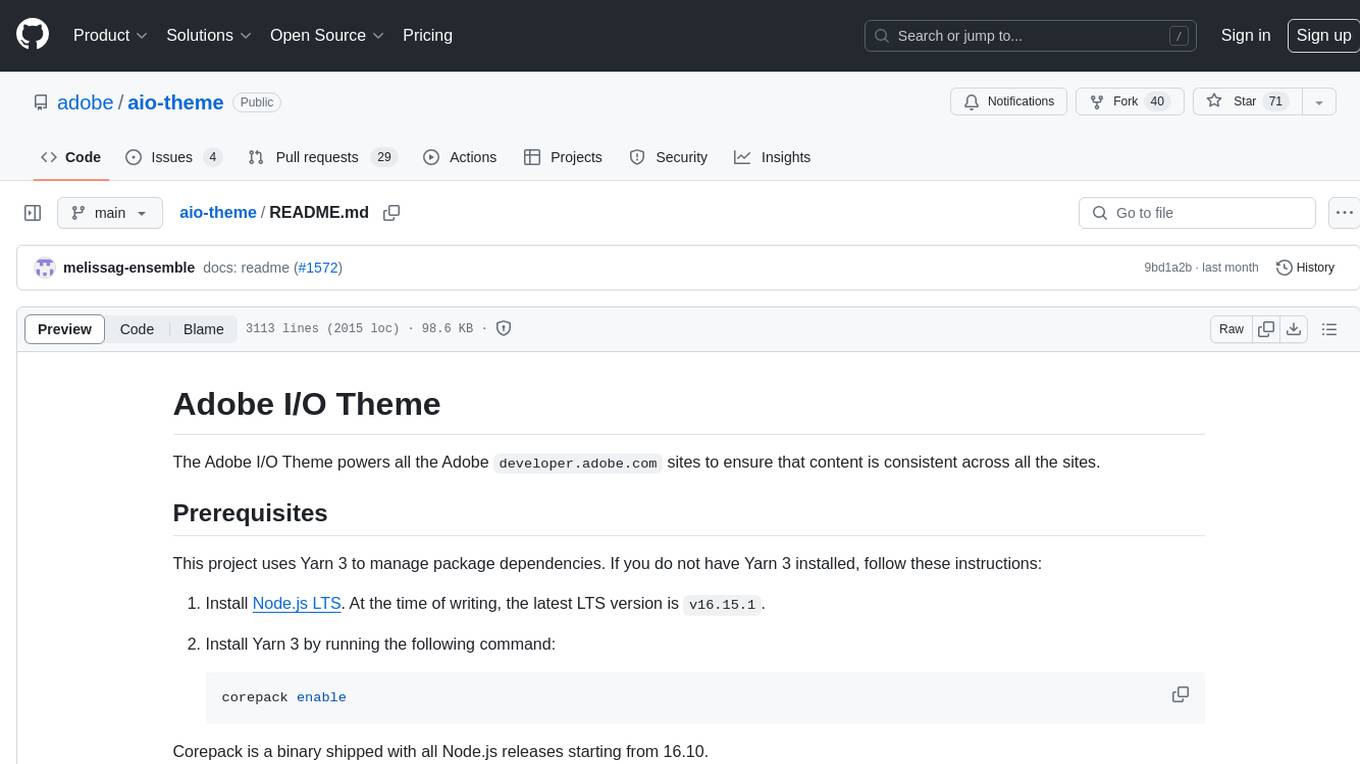
fabric
fabric is an open-source framework for augmenting humans using AI. It provides a modular framework for solving specific problems using a crowdsourced set of AI prompts that can be used anywhere.
Stars: 30329
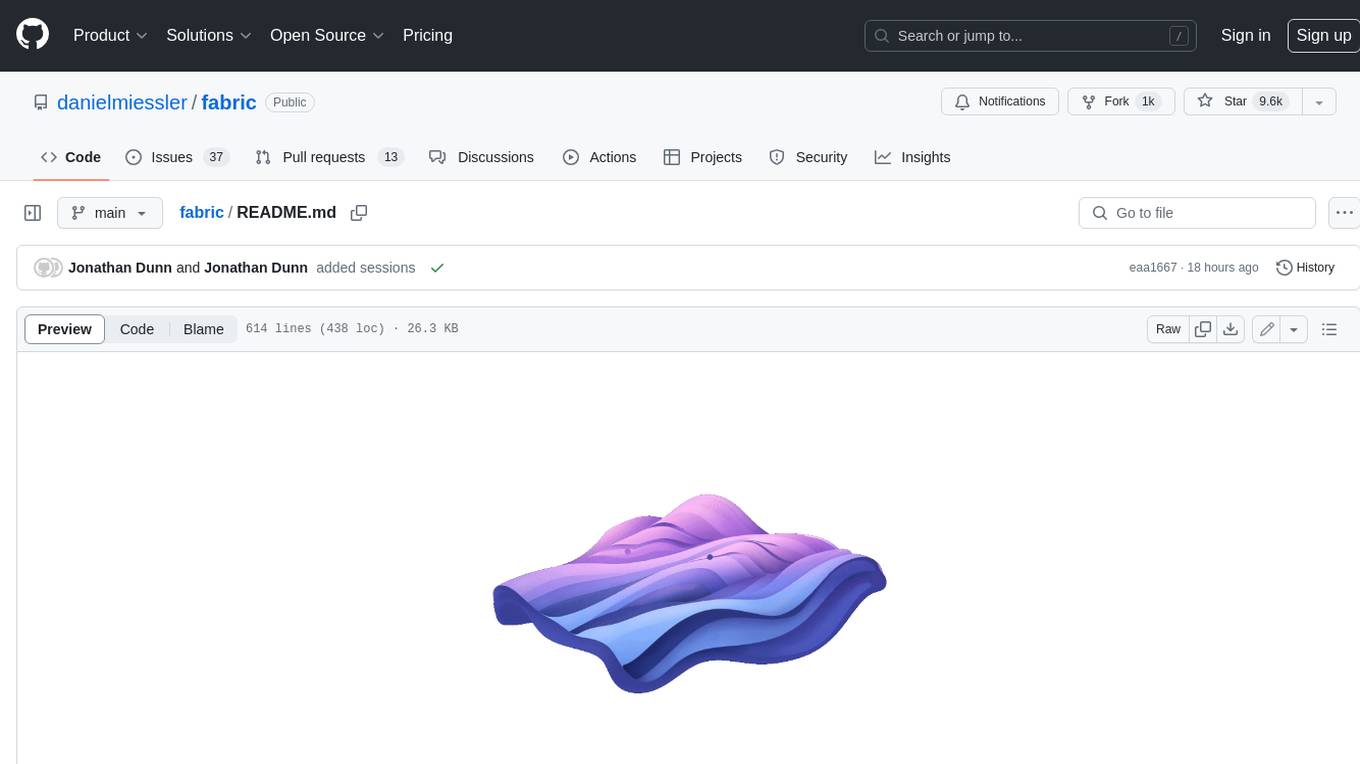
Fabric is an open-source framework for augmenting humans using AI. It provides a structured approach to breaking down problems into individual components and applying AI to them one at a time. Fabric includes a collection of pre-defined Patterns (prompts) that can be used for a variety of tasks, such as extracting the most interesting parts of YouTube videos and podcasts, writing essays, summarizing academic papers, creating AI art prompts, and more. Users can also create their own custom Patterns. Fabric is designed to be easy to use, with a command-line interface and a variety of helper apps. It is also extensible, allowing users to integrate it with their own AI applications and infrastructure.
README:

Updates • What and Why • Philosophy • Installation • Usage • Examples • Just Use the Patterns • Custom Patterns • Helper Apps • Meta
-
fabric
[!NOTE] February 24, 2025
- Fabric now supports Sonnet 3.7! Update and use
-Sto select it as your default if you want, or just use the shortcut-m claude-3-7-sonnet-latest. Enjoy!
Since the start of 2023 and GenAI we've seen a massive number of AI applications for accomplishing tasks. It's powerful, but it's not easy to integrate this functionality into our lives.
Fabric was created to address this by enabling everyone to granularly apply AI to everyday challenges.
Keep in mind that many of these were recorded when Fabric was Python-based, so remember to use the current install instructions below.
AI isn't a thing; it's a magnifier of a thing. And that thing is human creativity.
We believe the purpose of technology is to help humans flourish, so when we talk about AI we start with the human problems we want to solve.
Our approach is to break problems into individual pieces (see below) and then apply AI to them one at a time. See below for some examples.
Prompts are good for this, but the biggest challenge I faced in 2023——which still exists today—is the sheer number of AI prompts out there. We all have prompts that are useful, but it's hard to discover new ones, know if they are good or not, and manage different versions of the ones we like.
One of fabric's primary features is helping people collect and integrate prompts, which we call Patterns, into various parts of their lives.
Fabric has Patterns for all sorts of life and work activities, including:
- Extracting the most interesting parts of YouTube videos and podcasts
- Writing an essay in your own voice with just an idea as an input
- Summarizing opaque academic papers
- Creating perfectly matched AI art prompts for a piece of writing
- Rating the quality of content to see if you want to read/watch the whole thing
- Getting summaries of long, boring content
- Explaining code to you
- Turning bad documentation into usable documentation
- Creating social media posts from any content input
- And a million more…
To install Fabric, you can use the latest release binaries or install it from the source.
https://github.com/danielmiessler/fabric/releases/latest/download/fabric-windows-amd64.exe
curl -L https://github.com/danielmiessler/fabric/releases/latest/download/fabric-darwin-arm64 > fabric && chmod +x fabric && ./fabric --version
curl -L https://github.com/danielmiessler/fabric/releases/latest/download/fabric-darwin-amd64 > fabric && chmod +x fabric && ./fabric --version
curl -L https://github.com/danielmiessler/fabric/releases/latest/download/fabric-linux-amd64 > fabric && chmod +x fabric && ./fabric --version
curl -L https://github.com/danielmiessler/fabric/releases/latest/download/fabric-linux-arm64 > fabric && chmod +x fabric && ./fabric --version
NOTE: using Homebrew or the Arch Linux package managers makes fabric available as fabric-ai, so add
the following alias to your shell startup files to account for this:
alias fabric='fabric-ai'brew install fabric-ai
yay -S fabric-ai
To install Fabric, make sure Go is installed, and then run the following command.
# Install Fabric directly from the repo
go install github.com/danielmiessler/fabric@latestYou may need to set some environment variables in your ~/.bashrc on linux or ~/.zshrc file on mac to be able to run the fabric command. Here is an example of what you can add:
For Intel based macs or linux
# Golang environment variables
export GOROOT=/usr/local/go
export GOPATH=$HOME/go
# Update PATH to include GOPATH and GOROOT binaries
export PATH=$GOPATH/bin:$GOROOT/bin:$HOME/.local/bin:$PATHfor Apple Silicon based macs
# Golang environment variables
export GOROOT=$(brew --prefix go)/libexec
export GOPATH=$HOME/go
export PATH=$GOPATH/bin:$GOROOT/bin:$HOME/.local/bin:$PATHNow run the following command
# Run the setup to set up your directories and keys
fabric --setupIf everything works you are good to go.
In order to add aliases for all your patterns and use them directly as commands ie. summarize instead of fabric --pattern summarize
You can add the following to your .zshrc or .bashrc file.
# Loop through all files in the ~/.config/fabric/patterns directory
for pattern_file in $HOME/.config/fabric/patterns/*; do
# Get the base name of the file (i.e., remove the directory path)
pattern_name=$(basename "$pattern_file")
# Create an alias in the form: alias pattern_name="fabric --pattern pattern_name"
alias_command="alias $pattern_name='fabric --pattern $pattern_name'"
# Evaluate the alias command to add it to the current shell
eval "$alias_command"
done
yt() {
if [ "$#" -eq 0 ] || [ "$#" -gt 2 ]; then
echo "Usage: yt [-t | --timestamps] youtube-link"
echo "Use the '-t' flag to get the transcript with timestamps."
return 1
fi
transcript_flag="--transcript"
if [ "$1" = "-t" ] || [ "$1" = "--timestamps" ]; then
transcript_flag="--transcript-with-timestamps"
shift
fi
local video_link="$1"
fabric -y "$video_link" $transcript_flag
}You can add the below code for the equivalent aliases inside PowerShell by running notepad $PROFILE inside a PowerShell window:
# Path to the patterns directory
$patternsPath = Join-Path $HOME ".config/fabric/patterns"
foreach ($patternDir in Get-ChildItem -Path $patternsPath -Directory) {
$patternName = $patternDir.Name
# Dynamically define a function for each pattern
$functionDefinition = @"
function $patternName {
[CmdletBinding()]
param(
[Parameter(ValueFromPipeline = `$true)]
[string] `$InputObject,
[Parameter(ValueFromRemainingArguments = `$true)]
[String[]] `$patternArgs
)
begin {
# Initialize an array to collect pipeline input
`$collector = @()
}
process {
# Collect pipeline input objects
if (`$InputObject) {
`$collector += `$InputObject
}
}
end {
# Join all pipeline input into a single string, separated by newlines
`$pipelineContent = `$collector -join "`n"
# If there's pipeline input, include it in the call to fabric
if (`$pipelineContent) {
`$pipelineContent | fabric --pattern $patternName `$patternArgs
} else {
# No pipeline input; just call fabric with the additional args
fabric --pattern $patternName `$patternArgs
}
}
}
"@
# Add the function to the current session
Invoke-Expression $functionDefinition
}
# Define the 'yt' function as well
function yt {
[CmdletBinding()]
param(
[Parameter()]
[Alias("timestamps")]
[switch]$t,
[Parameter(Position = 0, ValueFromPipeline = $true)]
[string]$videoLink
)
begin {
$transcriptFlag = "--transcript"
if ($t) {
$transcriptFlag = "--transcript-with-timestamps"
}
}
process {
if (-not $videoLink) {
Write-Error "Usage: yt [-t | --timestamps] youtube-link"
return
}
}
end {
if ($videoLink) {
# Execute and allow output to flow through the pipeline
fabric -y $videoLink $transcriptFlag
}
}
}This also creates a yt alias that allows you to use yt https://www.youtube.com/watch?v=4b0iet22VIk to get transcripts, comments, and metadata.
If in addition to the above aliases you would like to have the option to save the output to your favorite markdown note vault like Obsidian then instead of the above add the following to your .zshrc or .bashrc file:
# Define the base directory for Obsidian notes
obsidian_base="/path/to/obsidian"
# Loop through all files in the ~/.config/fabric/patterns directory
for pattern_file in ~/.config/fabric/patterns/*; do
# Get the base name of the file (i.e., remove the directory path)
pattern_name=$(basename "$pattern_file")
# Remove any existing alias with the same name
unalias "$pattern_name" 2>/dev/null
# Define a function dynamically for each pattern
eval "
$pattern_name() {
local title=\$1
local date_stamp=\$(date +'%Y-%m-%d')
local output_path=\"\$obsidian_base/\${date_stamp}-\${title}.md\"
# Check if a title was provided
if [ -n \"\$title\" ]; then
# If a title is provided, use the output path
fabric --pattern \"$pattern_name\" -o \"\$output_path\"
else
# If no title is provided, use --stream
fabric --pattern \"$pattern_name\" --stream
fi
}
"
doneThis will allow you to use the patterns as aliases like in the above for example summarize instead of fabric --pattern summarize --stream, however if you pass in an extra argument like this summarize "my_article_title" your output will be saved in the destination that you set in obsidian_base="/path/to/obsidian" in the following format YYYY-MM-DD-my_article_title.md where the date gets autogenerated for you.
You can tweak the date format by tweaking the date_stamp format.
If you have the Legacy (Python) version installed and want to migrate to the Go version, here's how you do it. It's basically two steps: 1) uninstall the Python version, and 2) install the Go version.
# Uninstall Legacy Fabric
pipx uninstall fabric
# Clear any old Fabric aliases
(check your .bashrc, .zshrc, etc.)
# Install the Go version
go install github.com/danielmiessler/fabric@latest
# Run setup for the new version. Important because things have changed
fabric --setupThen set your environmental variables as shown above.
The great thing about Go is that it's super easy to upgrade. Just run the same command you used to install it in the first place and you'll always get the latest version.
go install github.com/danielmiessler/fabric@latestOnce you have it all set up, here's how to use it.
fabric -hUsage:
fabric [OPTIONS]
Application Options:
-p, --pattern= Choose a pattern from the available patterns
-v, --variable= Values for pattern variables, e.g. -v=#role:expert -v=#points:30
-C, --context= Choose a context from the available contexts
--session= Choose a session from the available sessions
-a, --attachment= Attachment path or URL (e.g. for OpenAI image recognition messages)
-S, --setup Run setup for all reconfigurable parts of fabric
-t, --temperature= Set temperature (default: 0.7)
-T, --topp= Set top P (default: 0.9)
-s, --stream Stream
-P, --presencepenalty= Set presence penalty (default: 0.0)
-r, --raw Use the defaults of the model without sending chat options (like temperature etc.) and use the user role instead of the system role for patterns.
-F, --frequencypenalty= Set frequency penalty (default: 0.0)
-l, --listpatterns List all patterns
-L, --listmodels List all available models
-x, --listcontexts List all contexts
-X, --listsessions List all sessions
-U, --updatepatterns Update patterns
-c, --copy Copy to clipboard
-m, --model= Choose model
--modelContextLength= Model context length (only affects ollama)
-o, --output= Output to file
--output-session Output the entire session (also a temporary one) to the output file
-n, --latest= Number of latest patterns to list (default: 0)
-d, --changeDefaultModel Change default model
-y, --youtube= YouTube video or play list "URL" to grab transcript, comments from it and send to chat or print it put to the console and store it in the output file
--playlist Prefer playlist over video if both ids are present in the URL
--transcript Grab transcript from YouTube video and send to chat (it is used per default).
--transcript-with-timestamps Grab transcript from YouTube video with timestamps and send to chat
--comments Grab comments from YouTube video and send to chat
--metadata Output video metadata
-g, --language= Specify the Language Code for the chat, e.g. -g=en -g=zh
-u, --scrape_url= Scrape website URL to markdown using Jina AI
-q, --scrape_question= Search question using Jina AI
-e, --seed= Seed to be used for LMM generation
-w, --wipecontext= Wipe context
-W, --wipesession= Wipe session
--printcontext= Print context
--printsession= Print session
--readability Convert HTML input into a clean, readable view
--input-has-vars Apply variables to user input
--dry-run Show what would be sent to the model without actually sending it
--serve Serve the Fabric Rest API
--serveOllama Serve the Fabric Rest API with ollama endpoints
--address= The address to bind the REST API (default: :8080)
--config= Path to YAML config file
--version Print current version
--listextensions List all registered extensions
--addextension= Register a new extension from config file path
--rmextension= Remove a registered extension by name
--strategy= Choose a strategy from the available strategies
--liststrategies List all strategies
Help Options:
-h, --help Show this help message
Fabric Patterns are different than most prompts you'll see.
-
First, we use
Markdownto help ensure maximum readability and editability. This not only helps the creator make a good one, but also anyone who wants to deeply understand what it does. Importantly, this also includes the AI you're sending it to!
Here's an example of a Fabric Pattern.
https://github.com/danielmiessler/fabric/blob/main/patterns/extract_wisdom/system.md-
Next, we are extremely clear in our instructions, and we use the Markdown structure to emphasize what we want the AI to do, and in what order.
-
And finally, we tend to use the System section of the prompt almost exclusively. In over a year of being heads-down with this stuff, we've just seen more efficacy from doing that. If that changes, or we're shown data that says otherwise, we will adjust.
The following examples use the macOS
pbpasteto paste from the clipboard. See the pbpaste section below for Windows and Linux alternatives.
Now let's look at some things you can do with Fabric.
-
Run the
summarizePattern based on input fromstdin. In this case, the body of an article.pbpaste | fabric --pattern summarize -
Run the
analyze_claimsPattern with the--streamoption to get immediate and streaming results.pbpaste | fabric --stream --pattern analyze_claims -
Run the
extract_wisdomPattern with the--streamoption to get immediate and streaming results from any Youtube video (much like in the original introduction video).fabric -y "https://youtube.com/watch?v=uXs-zPc63kM" --stream --pattern extract_wisdom -
Create patterns- you must create a .md file with the pattern and save it to
~/.config/fabric/patterns/[yourpatternname]. -
Run a
analyze_claimspattern on a website. Fabric uses Jina AI to scrape the URL into markdown format before sending it to the model.fabric -u https://github.com/danielmiessler/fabric/ -p analyze_claims
If you're not looking to do anything fancy, and you just want a lot of great prompts, you can navigate to the /patterns directory and start exploring!
We hope that if you used nothing else from Fabric, the Patterns by themselves will make the project useful.
You can use any of the Patterns you see there in any AI application that you have, whether that's ChatGPT or some other app or website. Our plan and prediction is that people will soon be sharing many more than those we've published, and they will be way better than ours.
The wisdom of crowds for the win.
Fabric also implements prompt strategies like "Chain of Thought" or "Chain of Draft" which can be used in addition to the basic patterns.
See the Thinking Faster by Writing Less paper and the Thought Generation section of Learn Prompting for examples of prompt strategies.
Each strategy is available as a small json file in the /strategies directory.
The prompt modification of the strategy is applied to the system prompt and passed on to the LLM in the chat session.
Use fabric -S and select the option to install the strategies in your ~/.config/fabric directory.
You may want to use Fabric to create your own custom Patterns—but not share them with others. No problem!
Just make a directory in ~/.config/custompatterns/ (or wherever) and put your .md files in there.
When you're ready to use them, copy them into ~/.config/fabric/patterns/
You can then use them like any other Patterns, but they won't be public unless you explicitly submit them as Pull Requests to the Fabric project. So don't worry—they're private to you.
Fabric also makes use of some core helper apps (tools) to make it easier to integrate with your various workflows. Here are some examples:
to_pdf is a helper command that converts LaTeX files to PDF format. You can use it like this:
to_pdf input.texThis will create a PDF file from the input LaTeX file in the same directory.
You can also use it with stdin which works perfectly with the write_latex pattern:
echo "ai security primer" | fabric --pattern write_latex | to_pdfThis will create a PDF file named output.pdf in the current directory.
To install to_pdf, install it the same way as you install Fabric, just with a different repo name.
go install github.com/danielmiessler/fabric/plugins/tools/to_pdf@latestMake sure you have a LaTeX distribution (like TeX Live or MiKTeX) installed on your system, as to_pdf requires pdflatex to be available in your system's PATH.
code_helper is used in conjunction with the create_coding_feature pattern.
It generates a json representation of a directory of code that can be fed into an AI model
with instructions to create a new feature or edit the code in a specified way.
See the Create Coding Feature Pattern README for details.
Install it first using:
go install github.com/danielmiessler/fabric/plugins/tools/code_helper@latestThe examples use the macOS program pbpaste to paste content from the clipboard to pipe into fabric as the input. pbpaste is not available on Windows or Linux, but there are alternatives.
On Windows, you can use the PowerShell command Get-Clipboard from a PowerShell command prompt. If you like, you can also alias it to pbpaste. If you are using classic PowerShell, edit the file ~\Documents\WindowsPowerShell\.profile.ps1, or if you are using PowerShell Core, edit ~\Documents\PowerShell\.profile.ps1 and add the alias,
Set-Alias pbpaste Get-ClipboardOn Linux, you can use xclip -selection clipboard -o to paste from the clipboard. You will likely need to install xclip with your package manager. For Debian based systems including Ubuntu,
sudo apt update
sudo apt install xclip -yYou can also create an alias by editing ~/.bashrc or ~/.zshrc and adding the alias,
alias pbpaste='xclip -selection clipboard -o'Fabric now includes a built-in web interface that provides a GUI alternative to the command-line interface and an out-of-the-box website for those who want to get started with web development or blogging. You can use this app as a GUI interface for Fabric, a ready to go blog-site, or a website template for your own projects.
The web/src/lib/content directory includes starter .obsidian/ and templates/ directories, allowing you to open up the web/src/lib/content/ directory as an Obsidian.md vault. You can place your posts in the posts directory when you're ready to publish.
The GUI can be installed by navigating to the web directory and using npm install, pnpm install, or your favorite package manager. Then simply run the development server to start the app.
You will need to run fabric in a separate terminal with the fabric --serve command.
From the fabric project web/ directory:
npm run dev
## or ##
pnpm run dev
## or your equivalentTo run the Streamlit user interface:
# Install required dependencies
pip install -r requirements.txt
# Or manually install dependencies
pip install streamlit pandas matplotlib seaborn numpy python-dotenv pyperclip
# Run the Streamlit app
streamlit run streamlit.pyThe Streamlit UI provides a user-friendly interface for:
- Running and chaining patterns
- Managing pattern outputs
- Creating and editing patterns
- Analyzing pattern results
The Streamlit UI supports clipboard operations across different platforms:
-
macOS: Uses
pbcopyandpbpaste(built-in) -
Windows: Uses
pypercliplibrary (install withpip install pyperclip) -
Linux: Uses
xclip(install withsudo apt-get install xclipor equivalent for your distro)
[!NOTE] Special thanks to the following people for their inspiration and contributions!
- Jonathan Dunn for being the absolute MVP dev on the project, including spearheading the new Go version, as well as the GUI! All this while also being a full-time medical doctor!
- Caleb Sima for pushing me over the edge of whether to make this a public project or not.
- Eugen Eisler and Frederick Ros for their invaluable contributions to the Go version
- David Peters for his work on the web interface.
- Joel Parish for super useful input on the project's Github directory structure..
-
Joseph Thacker for the idea of a
-ccontext flag that adds pre-created context in the./config/fabric/directory to all Pattern queries. -
Jason Haddix for the idea of a stitch (chained Pattern) to filter content using a local model before sending on to a cloud model, i.e., cleaning customer data using
llama2before sending on togpt-4for analysis. - Andre Guerra for assisting with numerous components to make things simpler and more maintainable.
fabric was created by Daniel Miessler in January of 2024.
For Tasks:
Click tags to check more tools for each tasksFor Jobs:
Alternative AI tools for fabric
Similar Open Source Tools

fabric
Fabric is an open-source framework for augmenting humans using AI. It provides a structured approach to breaking down problems into individual components and applying AI to them one at a time. Fabric includes a collection of pre-defined Patterns (prompts) that can be used for a variety of tasks, such as extracting the most interesting parts of YouTube videos and podcasts, writing essays, summarizing academic papers, creating AI art prompts, and more. Users can also create their own custom Patterns. Fabric is designed to be easy to use, with a command-line interface and a variety of helper apps. It is also extensible, allowing users to integrate it with their own AI applications and infrastructure.

telemetry-airflow
This repository codifies the Airflow cluster that is deployed at workflow.telemetry.mozilla.org (behind SSO) and commonly referred to as "WTMO" or simply "Airflow". Some links relevant to users and developers of WTMO: * The `dags` directory in this repository contains some custom DAG definitions * Many of the DAGs registered with WTMO don't live in this repository, but are instead generated from ETL task definitions in bigquery-etl * The Data SRE team maintains a WTMO Developer Guide (behind SSO)
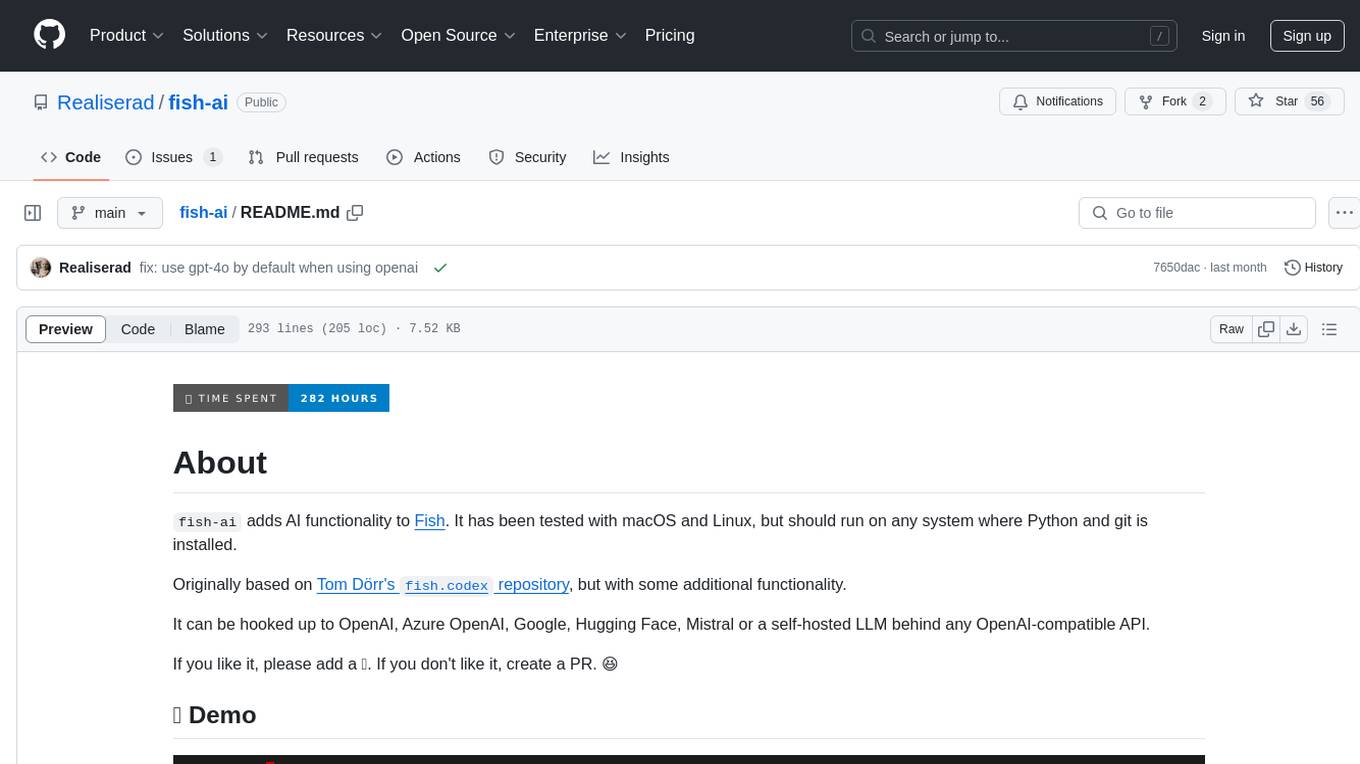
fish-ai
fish-ai is a tool that adds AI functionality to Fish shell. It can be integrated with various AI providers like OpenAI, Azure OpenAI, Google, Hugging Face, Mistral, or a self-hosted LLM. Users can transform comments into commands, autocomplete commands, and suggest fixes. The tool allows customization through configuration files and supports switching between contexts. Data privacy is maintained by redacting sensitive information before submission to the AI models. Development features include debug logging, testing, and creating releases.
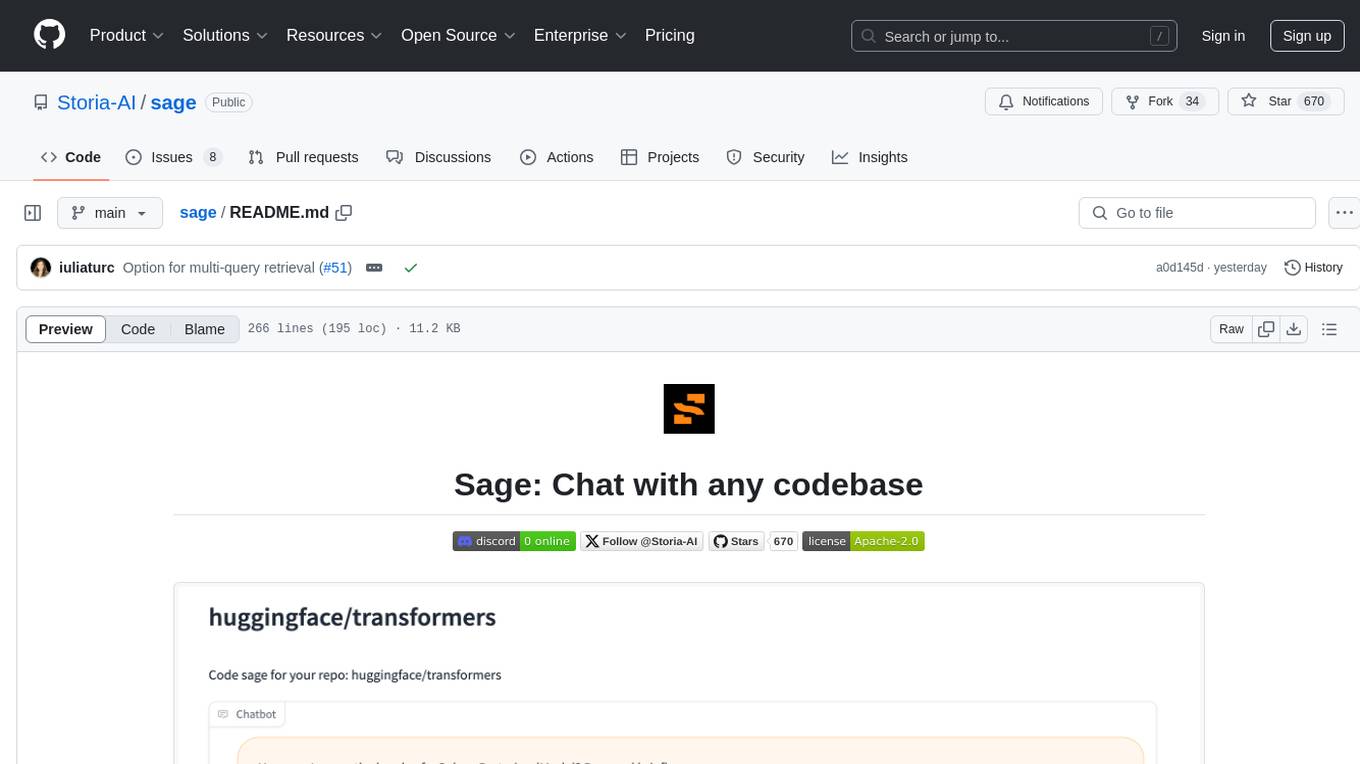
sage
Sage is a tool that allows users to chat with any codebase, providing a chat interface for code understanding and integration. It simplifies the process of learning how a codebase works by offering heavily documented answers sourced directly from the code. Users can set up Sage locally or on the cloud with minimal effort. The tool is designed to be easily customizable, allowing users to swap components of the pipeline and improve the algorithms powering code understanding and generation.
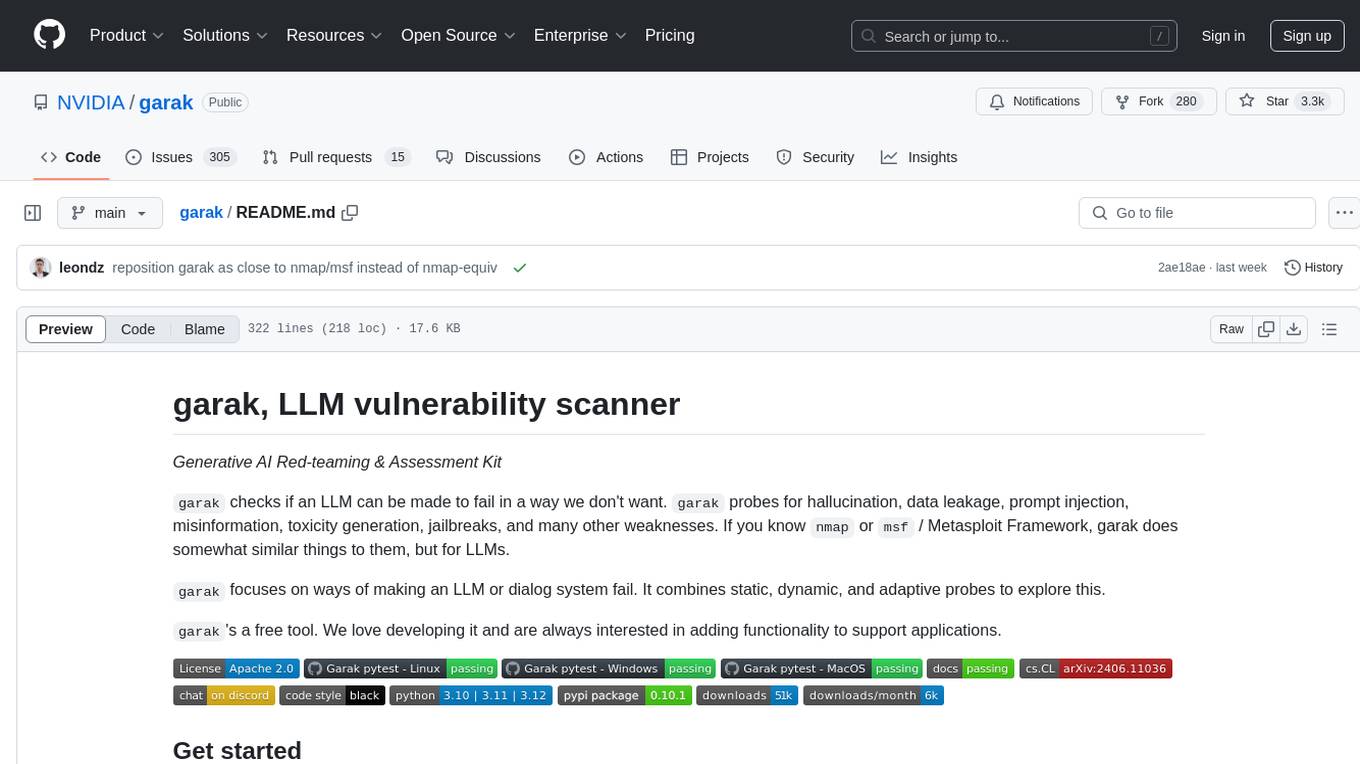
garak
Garak is a vulnerability scanner designed for LLMs (Large Language Models) that checks for various weaknesses such as hallucination, data leakage, prompt injection, misinformation, toxicity generation, and jailbreaks. It combines static, dynamic, and adaptive probes to explore vulnerabilities in LLMs. Garak is a free tool developed for red-teaming and assessment purposes, focusing on making LLMs or dialog systems fail. It supports various LLM models and can be used to assess their security and robustness.
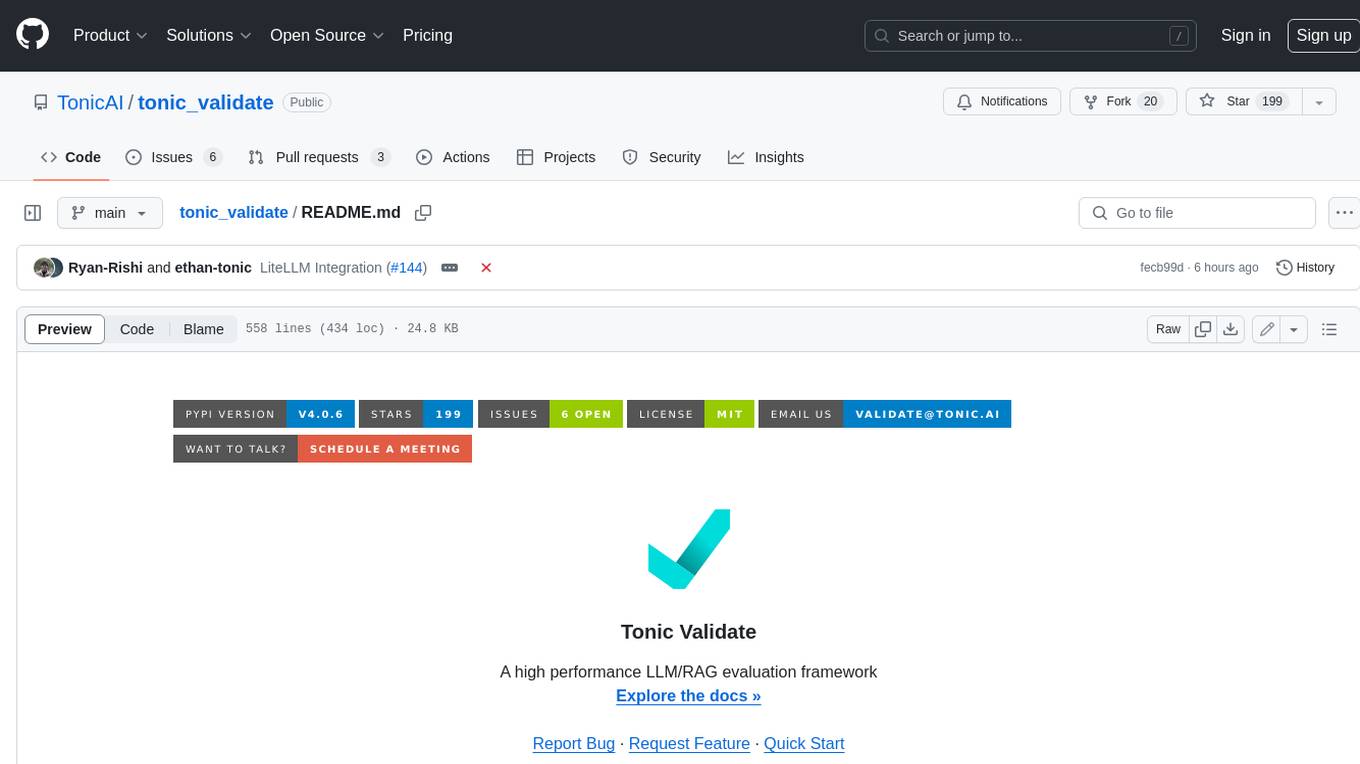
tonic_validate
Tonic Validate is a framework for the evaluation of LLM outputs, such as Retrieval Augmented Generation (RAG) pipelines. Validate makes it easy to evaluate, track, and monitor your LLM and RAG applications. Validate allows you to evaluate your LLM outputs through the use of our provided metrics which measure everything from answer correctness to LLM hallucination. Additionally, Validate has an optional UI to visualize your evaluation results for easy tracking and monitoring.
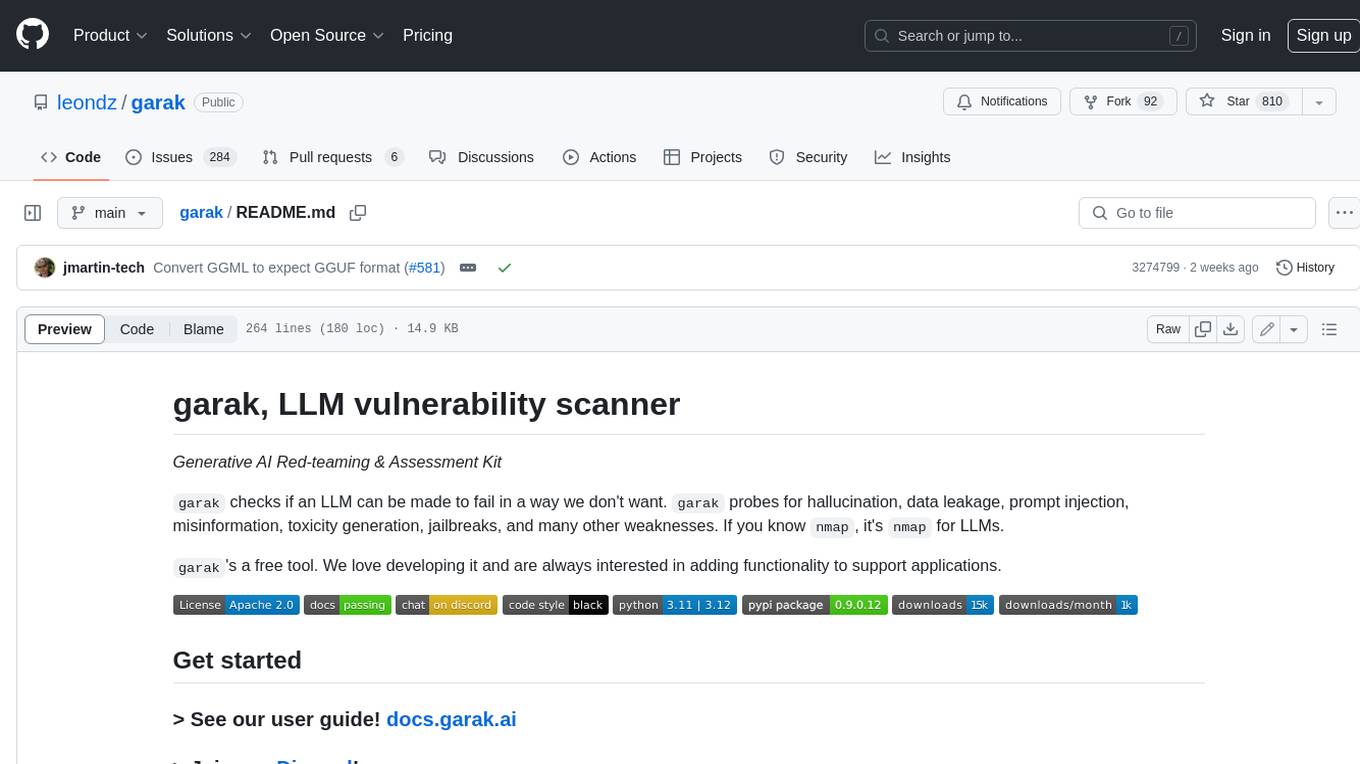
garak
Garak is a free tool that checks if a Large Language Model (LLM) can be made to fail in a way that is undesirable. It probes for hallucination, data leakage, prompt injection, misinformation, toxicity generation, jailbreaks, and many other weaknesses. Garak's a free tool. We love developing it and are always interested in adding functionality to support applications.
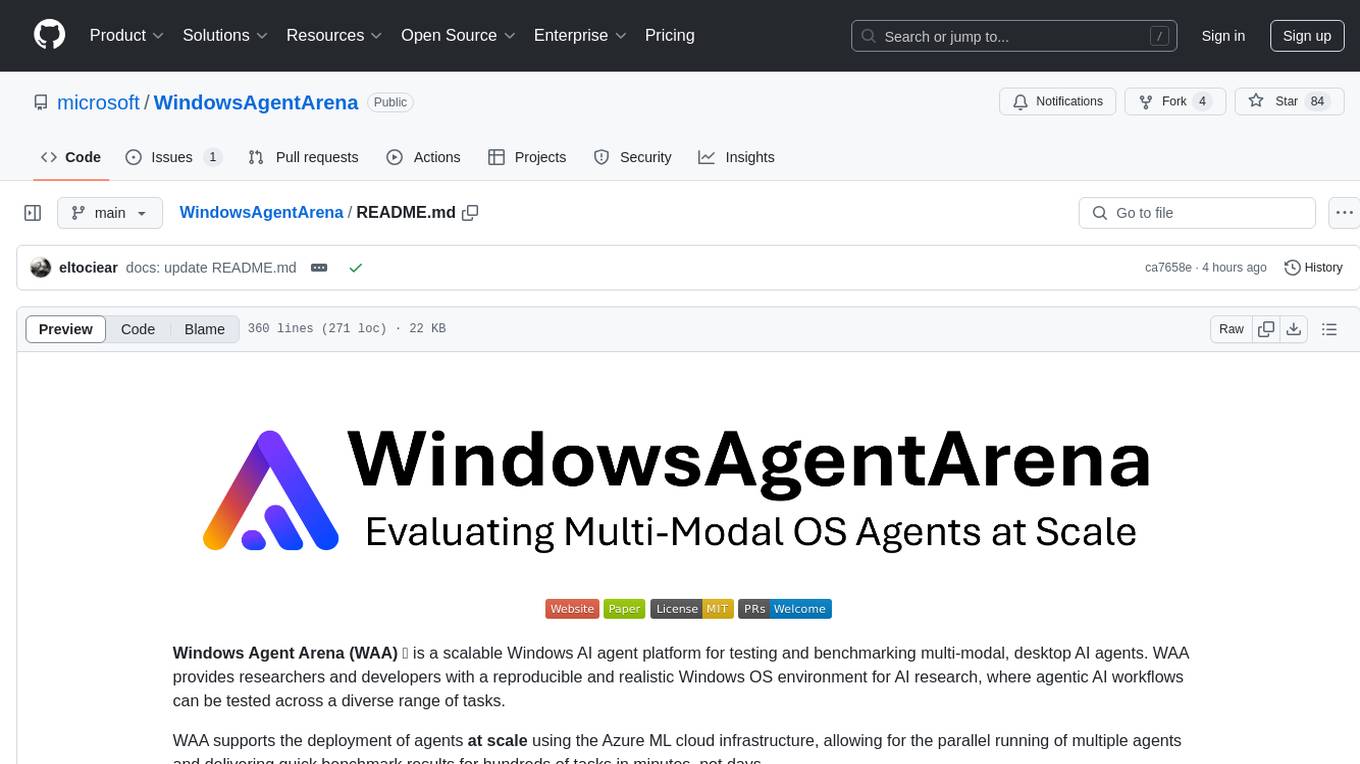
WindowsAgentArena
Windows Agent Arena (WAA) is a scalable Windows AI agent platform designed for testing and benchmarking multi-modal, desktop AI agents. It provides researchers and developers with a reproducible and realistic Windows OS environment for AI research, enabling testing of agentic AI workflows across various tasks. WAA supports deploying agents at scale using Azure ML cloud infrastructure, allowing parallel running of multiple agents and delivering quick benchmark results for hundreds of tasks in minutes.
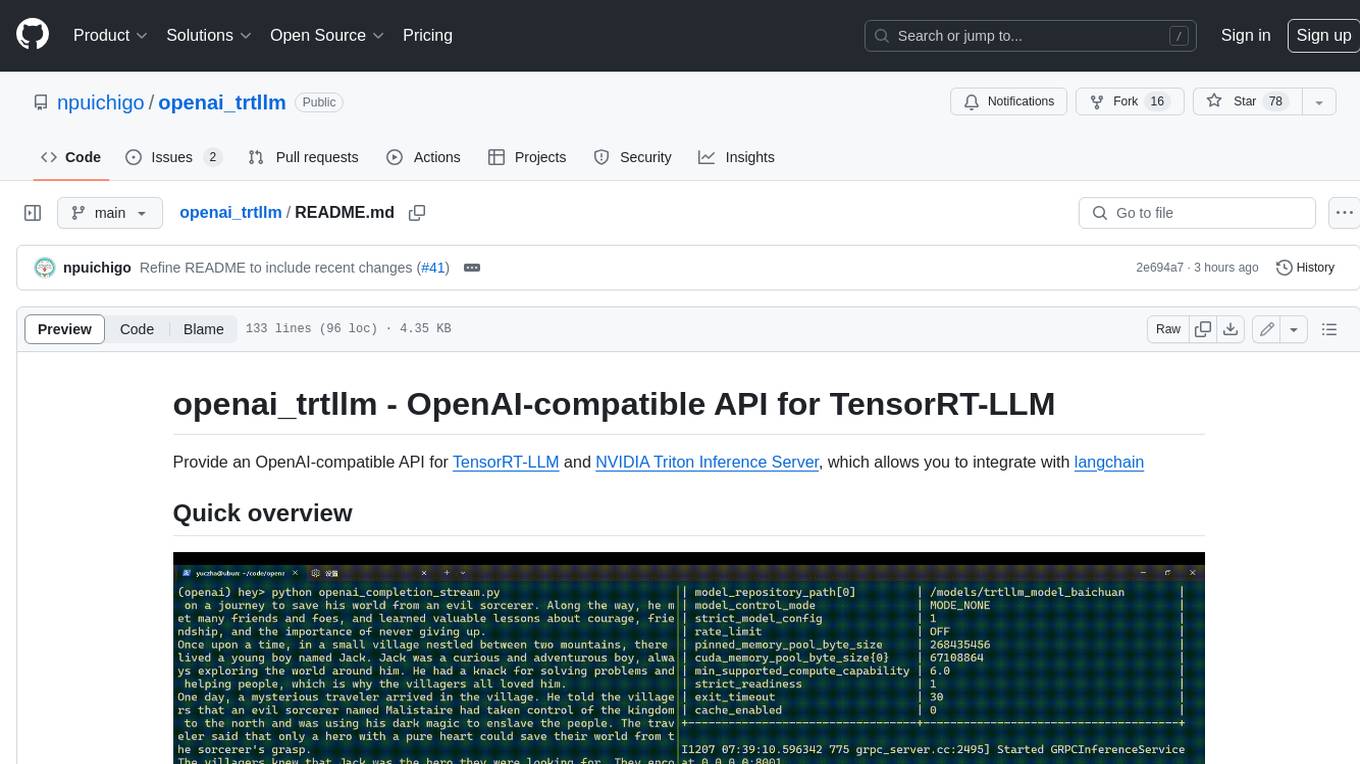
openai_trtllm
OpenAI-compatible API for TensorRT-LLM and NVIDIA Triton Inference Server, which allows you to integrate with langchain
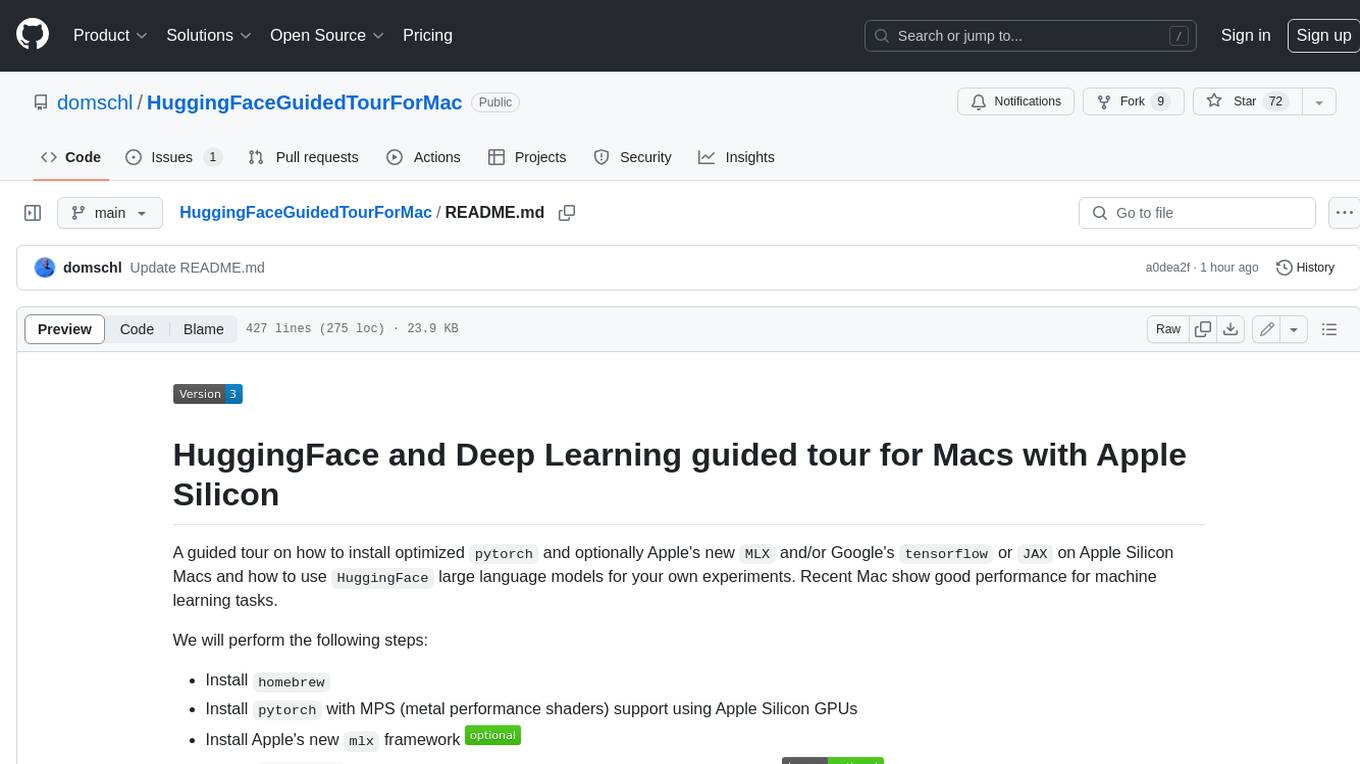
HuggingFaceGuidedTourForMac
HuggingFaceGuidedTourForMac is a guided tour on how to install optimized pytorch and optionally Apple's new MLX, JAX, and TensorFlow on Apple Silicon Macs. The repository provides steps to install homebrew, pytorch with MPS support, MLX, JAX, TensorFlow, and Jupyter lab. It also includes instructions on running large language models using HuggingFace transformers. The repository aims to help users set up their Macs for deep learning experiments with optimized performance.
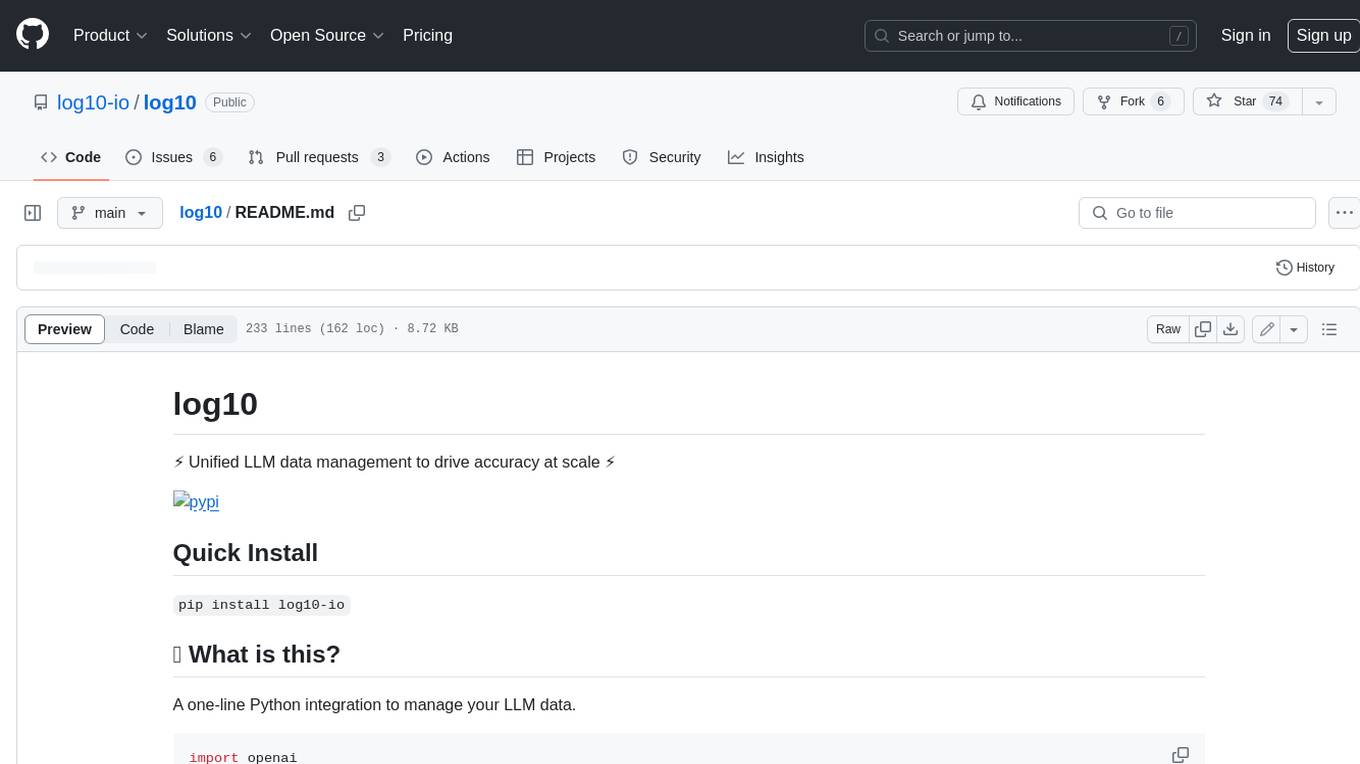
log10
Log10 is a one-line Python integration to manage your LLM data. It helps you log both closed and open-source LLM calls, compare and identify the best models and prompts, store feedback for fine-tuning, collect performance metrics such as latency and usage, and perform analytics and monitor compliance for LLM powered applications. Log10 offers various integration methods, including a python LLM library wrapper, the Log10 LLM abstraction, and callbacks, to facilitate its use in both existing production environments and new projects. Pick the one that works best for you. Log10 also provides a copilot that can help you with suggestions on how to optimize your prompt, and a feedback feature that allows you to add feedback to your completions. Additionally, Log10 provides prompt provenance, session tracking and call stack functionality to help debug prompt chains. With Log10, you can use your data and feedback from users to fine-tune custom models with RLHF, and build and deploy more reliable, accurate and efficient self-hosted models. Log10 also supports collaboration, allowing you to create flexible groups to share and collaborate over all of the above features.
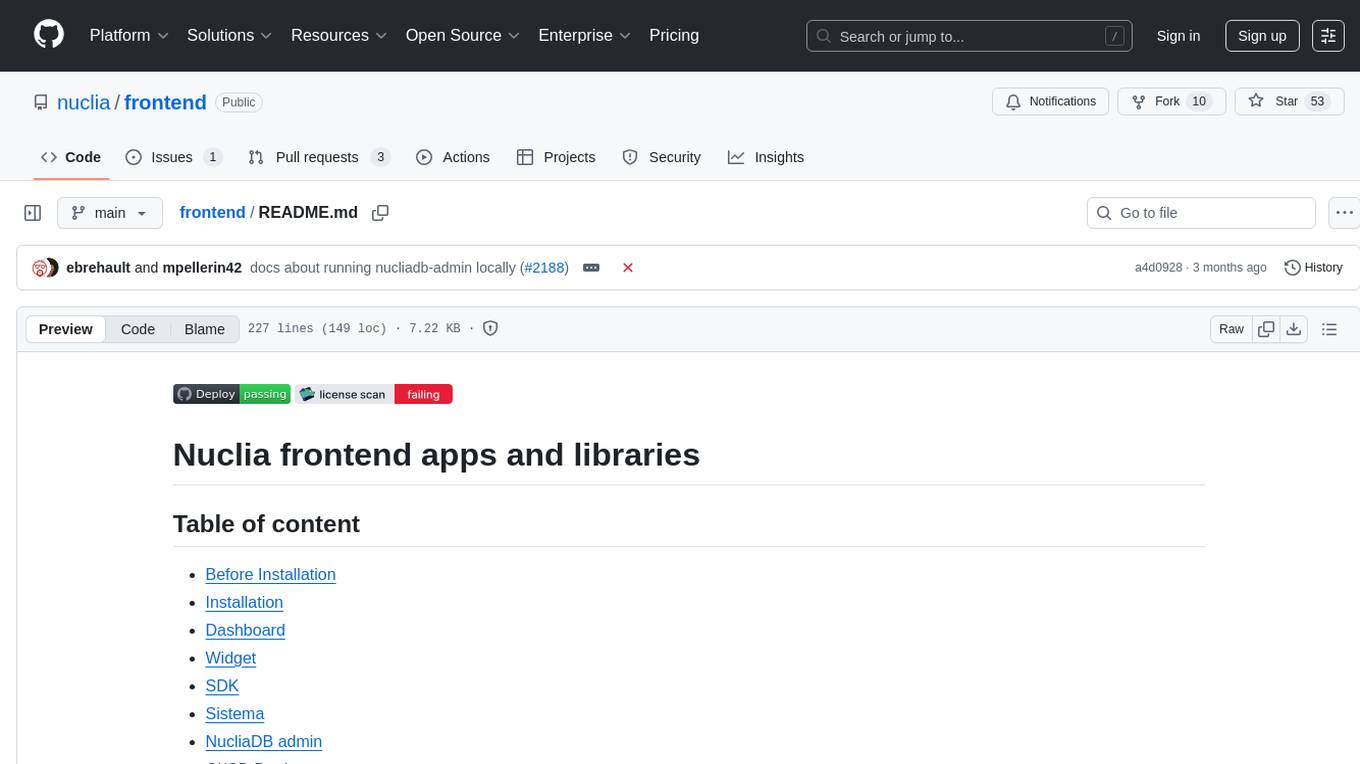
frontend
Nuclia frontend apps and libraries repository contains various frontend applications and libraries for the Nuclia platform. It includes components such as Dashboard, Widget, SDK, Sistema (design system), NucliaDB admin, CI/CD Deployment, and Maintenance page. The repository provides detailed instructions on installation, dependencies, and usage of these components for both Nuclia employees and external developers. It also covers deployment processes for different components and tools like ArgoCD for monitoring deployments and logs. The repository aims to facilitate the development, testing, and deployment of frontend applications within the Nuclia ecosystem.
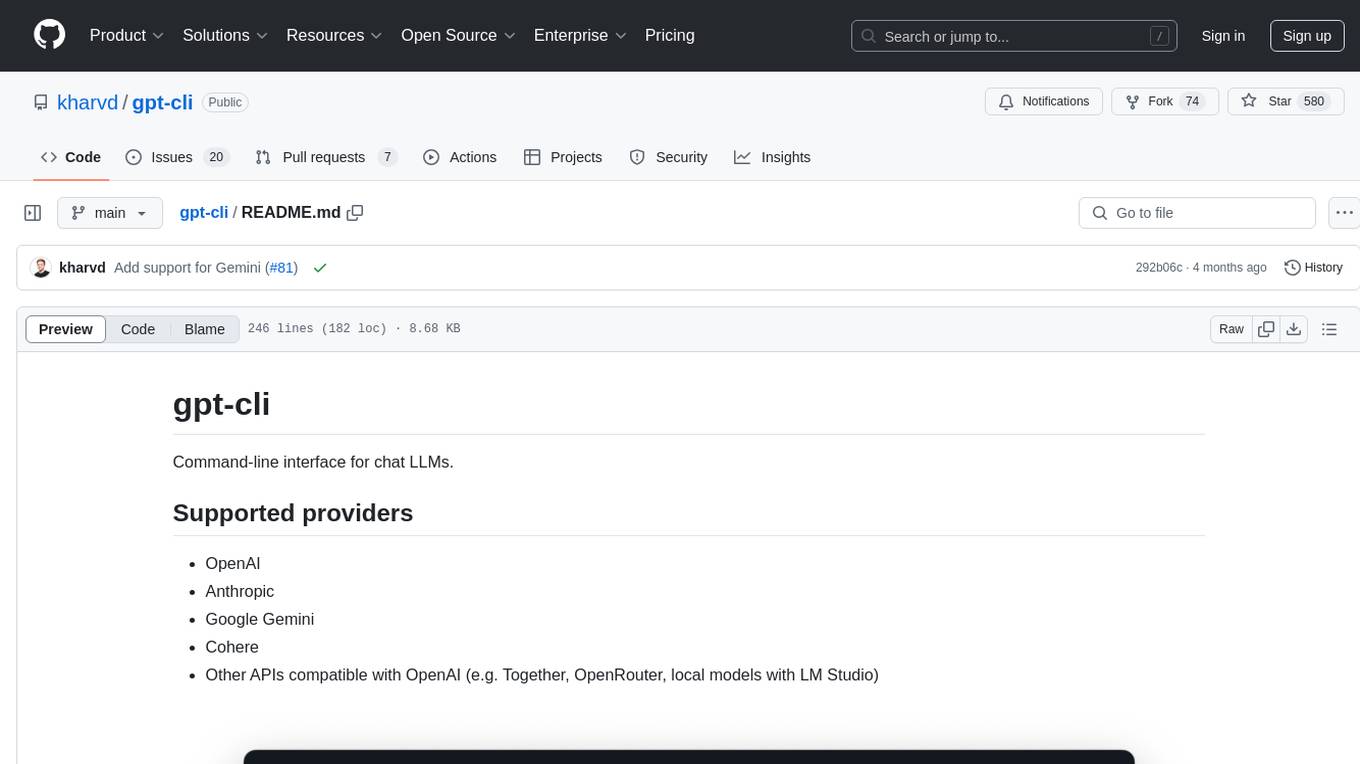
gpt-cli
gpt-cli is a command-line interface tool for interacting with various chat language models like ChatGPT, Claude, and others. It supports model customization, usage tracking, keyboard shortcuts, multi-line input, markdown support, predefined messages, and multiple assistants. Users can easily switch between different assistants, define custom assistants, and configure model parameters and API keys in a YAML file for easy customization and management.
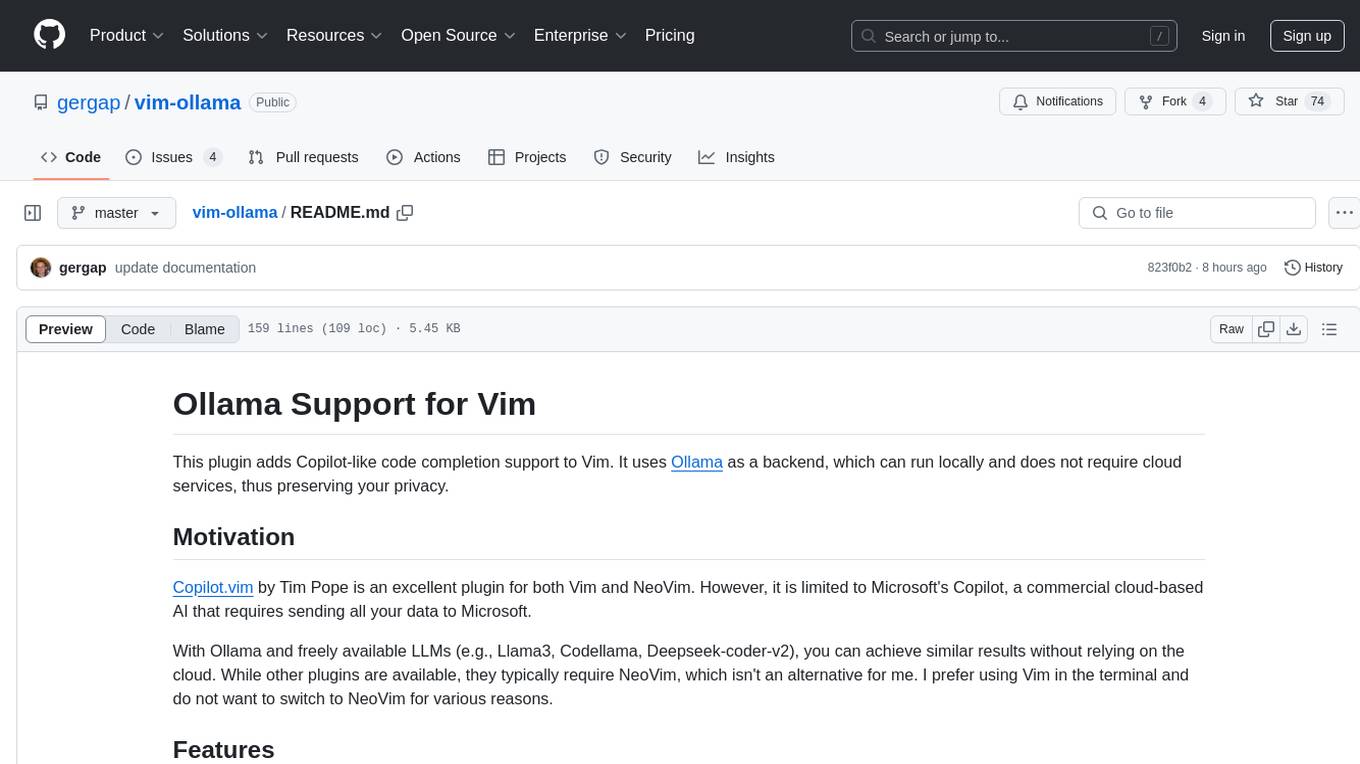
vim-ollama
The 'vim-ollama' plugin for Vim adds Copilot-like code completion support using Ollama as a backend, enabling intelligent AI-based code completion and integrated chat support for code reviews. It does not rely on cloud services, preserving user privacy. The plugin communicates with Ollama via Python scripts for code completion and interactive chat, supporting Vim only. Users can configure LLM models for code completion tasks and interactive conversations, with detailed installation and usage instructions provided in the README.
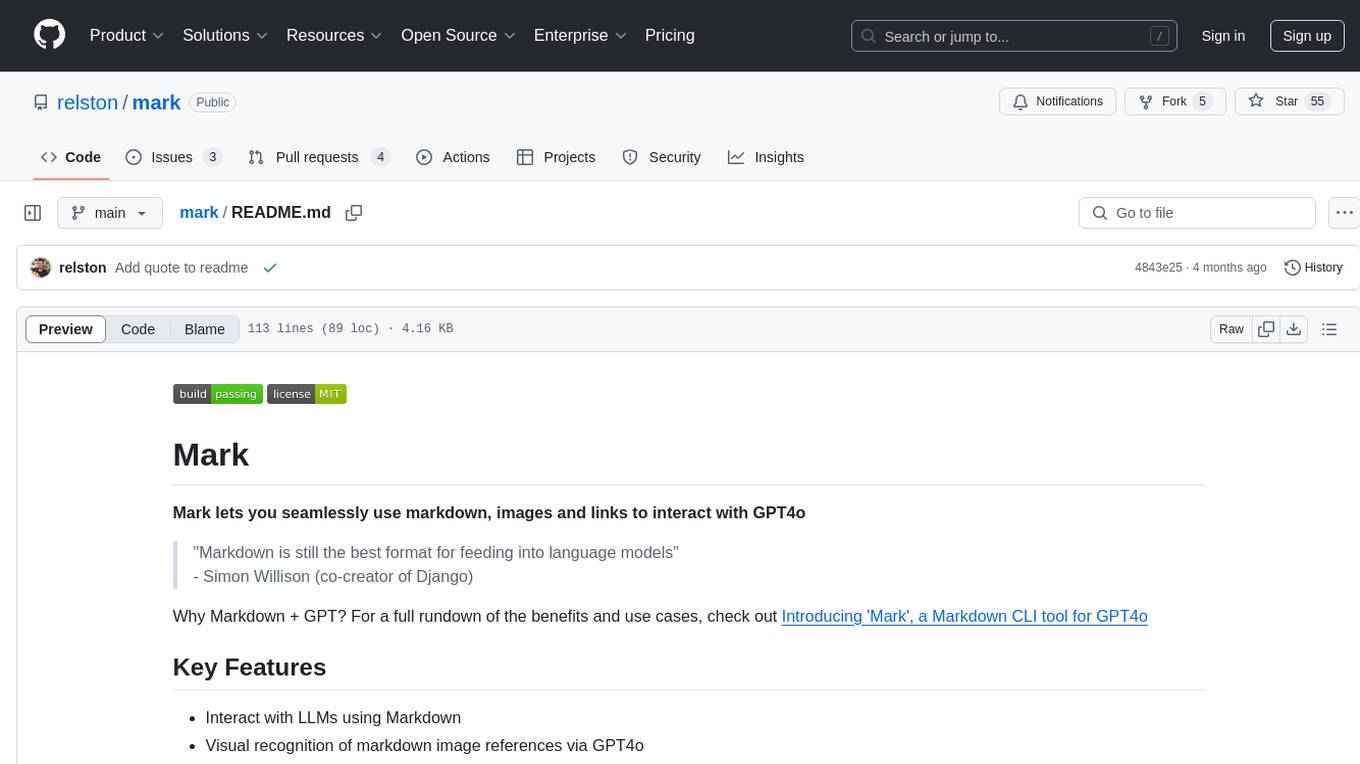
mark
Mark is a CLI tool that allows users to interact with large language models (LLMs) using Markdown format. It enables users to seamlessly integrate GPT responses into Markdown files, supports image recognition, scraping of local and remote links, and image generation. Mark focuses on using Markdown as both a prompt and response medium for LLMs, offering a unique and flexible way to interact with language models for various use cases in development and documentation processes.
For similar tasks

fabric
Fabric is an open-source framework for augmenting humans using AI. It provides a structured approach to breaking down problems into individual components and applying AI to them one at a time. Fabric includes a collection of pre-defined Patterns (prompts) that can be used for a variety of tasks, such as extracting the most interesting parts of YouTube videos and podcasts, writing essays, summarizing academic papers, creating AI art prompts, and more. Users can also create their own custom Patterns. Fabric is designed to be easy to use, with a command-line interface and a variety of helper apps. It is also extensible, allowing users to integrate it with their own AI applications and infrastructure.

Fabric
Fabric is an open-source framework designed to augment humans using AI by organizing prompts by real-world tasks. It addresses the integration problem of AI by creating and organizing prompts for various tasks. Users can create, collect, and organize AI solutions in a single place for use in their favorite tools. Fabric also serves as a command-line interface for those focused on the terminal. It offers a wide range of features and capabilities, including support for multiple AI providers, internationalization, speech-to-text, AI reasoning, model management, web search, text-to-speech, desktop notifications, and more. The project aims to help humans flourish by leveraging AI technology to solve human problems and enhance creativity.
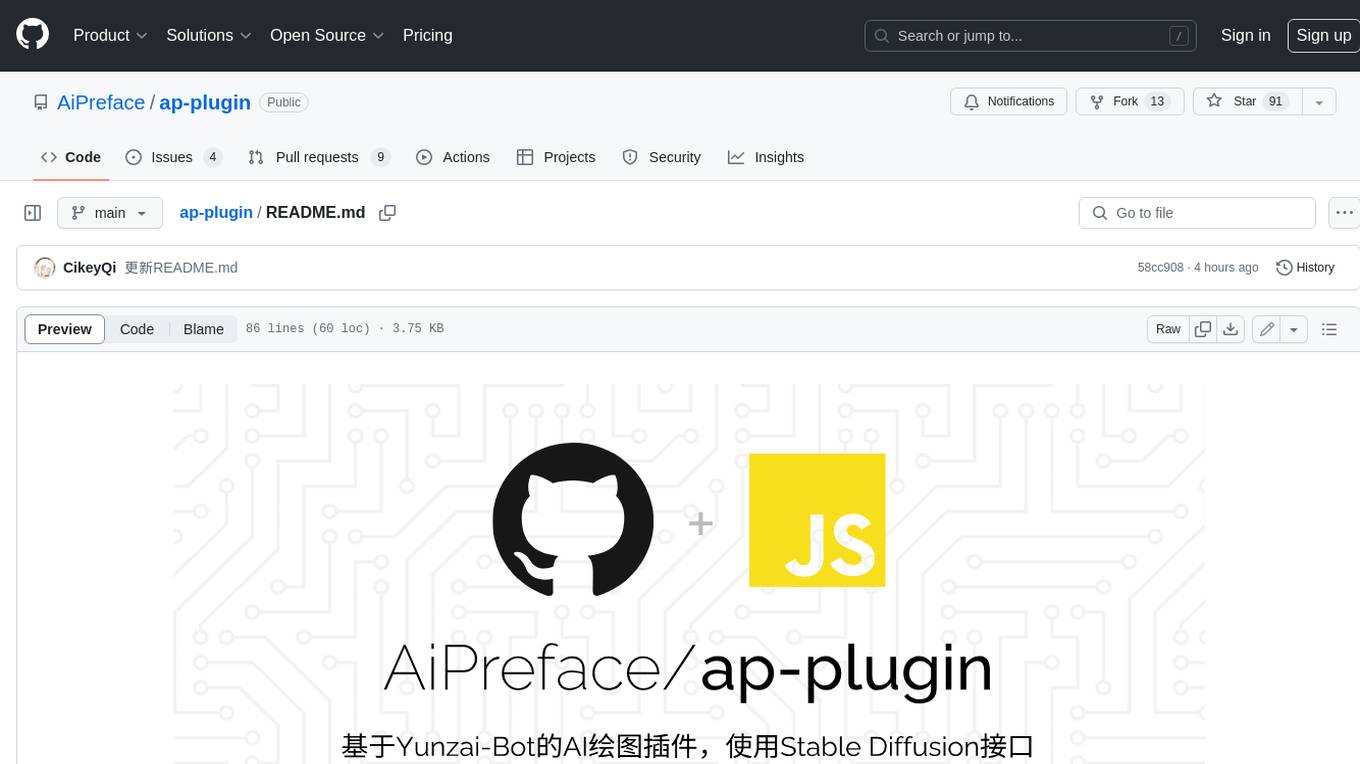
ap-plugin
AP-PLUGIN is an AI drawing plugin for the Yunzai series robot framework, allowing you to have a convenient AI drawing experience in the input box. It uses the open source Stable Diffusion web UI as the backend, deploys it for free, and generates a variety of images with richer functions.
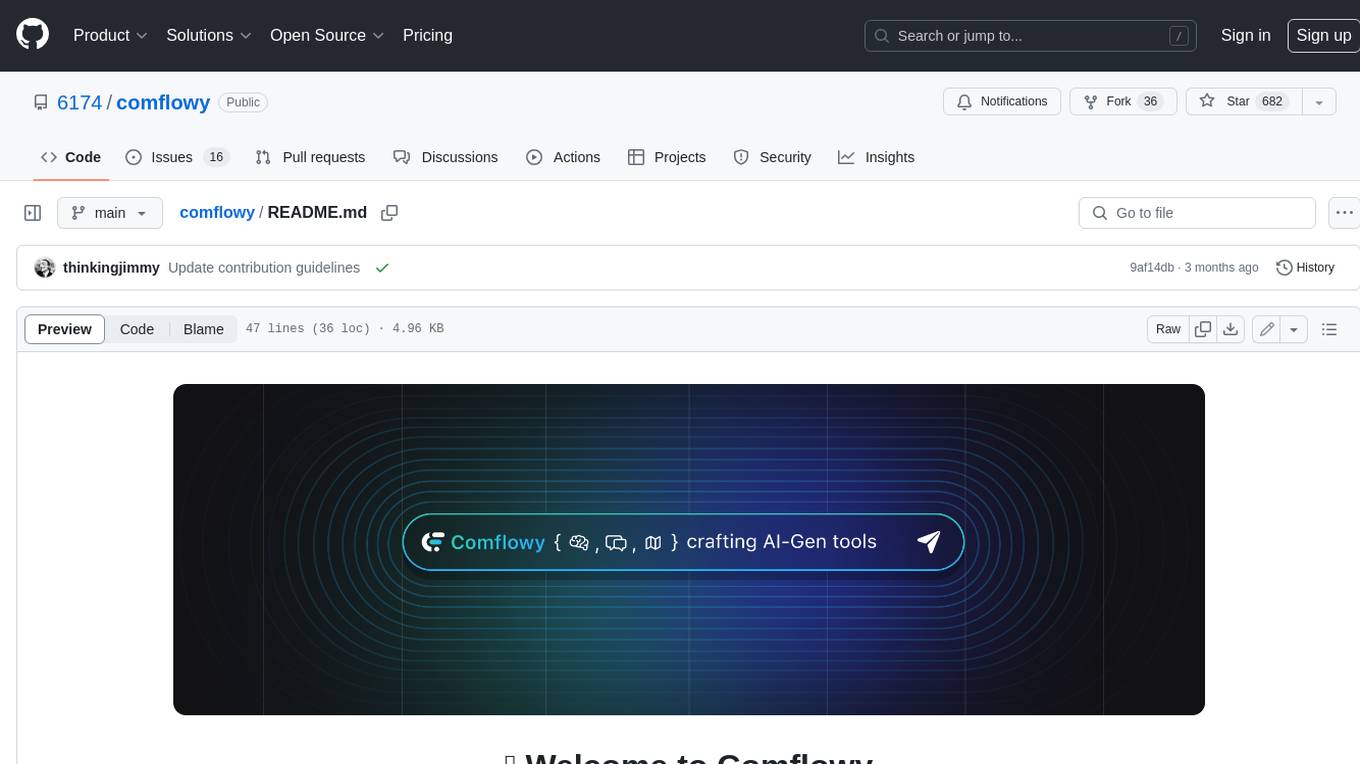
comflowy
Comflowy is a community dedicated to providing comprehensive tutorials, fostering discussions, and building a database of workflows and models for ComfyUI and Stable Diffusion. Our mission is to lower the entry barrier for ComfyUI users, promote its mainstream adoption, and contribute to the growth of the AI generative graphics community.
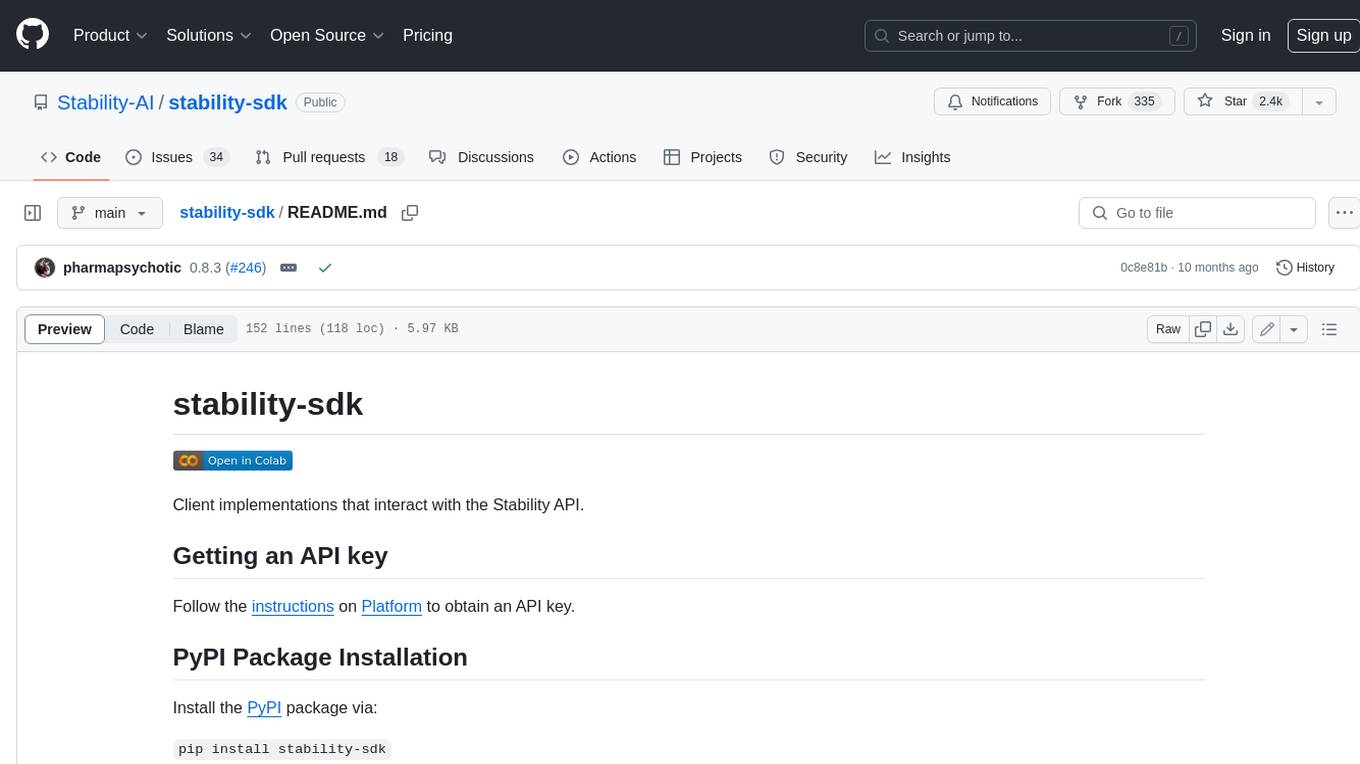
stability-sdk
The stability-sdk is a Python package that provides a client implementation for interacting with the Stability API. This API allows users to generate images, upscale images, and animate images using a variety of different models and settings. The stability-sdk makes it easy to use the Stability API from Python code, and it provides a number of helpful features such as command line usage, support for multiple models, and the ability to filter artifacts by type.
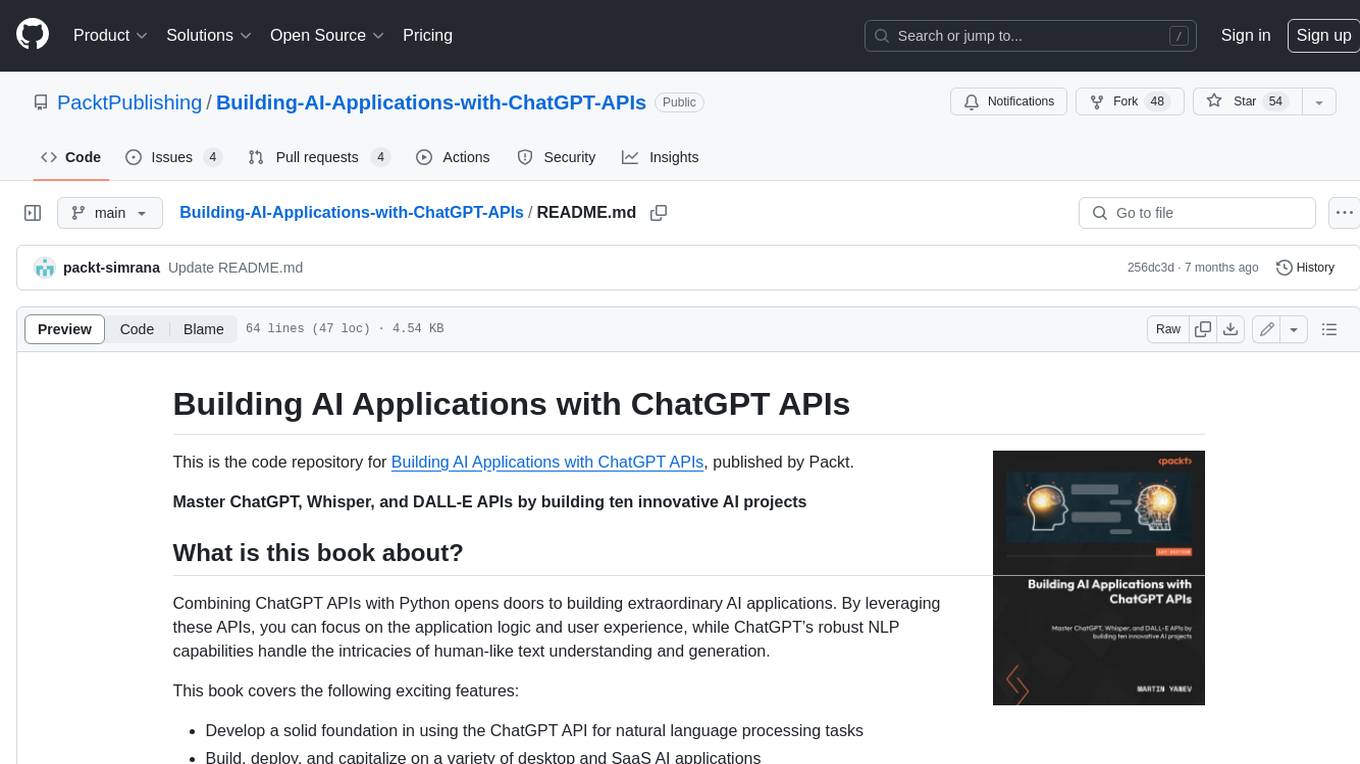
Building-AI-Applications-with-ChatGPT-APIs
This repository is for the book 'Building AI Applications with ChatGPT APIs' published by Packt. It provides code examples and instructions for mastering ChatGPT, Whisper, and DALL-E APIs through building innovative AI projects. Readers will learn to develop AI applications using ChatGPT APIs, integrate them with frameworks like Flask and Django, create AI-generated art with DALL-E APIs, and optimize ChatGPT models through fine-tuning.
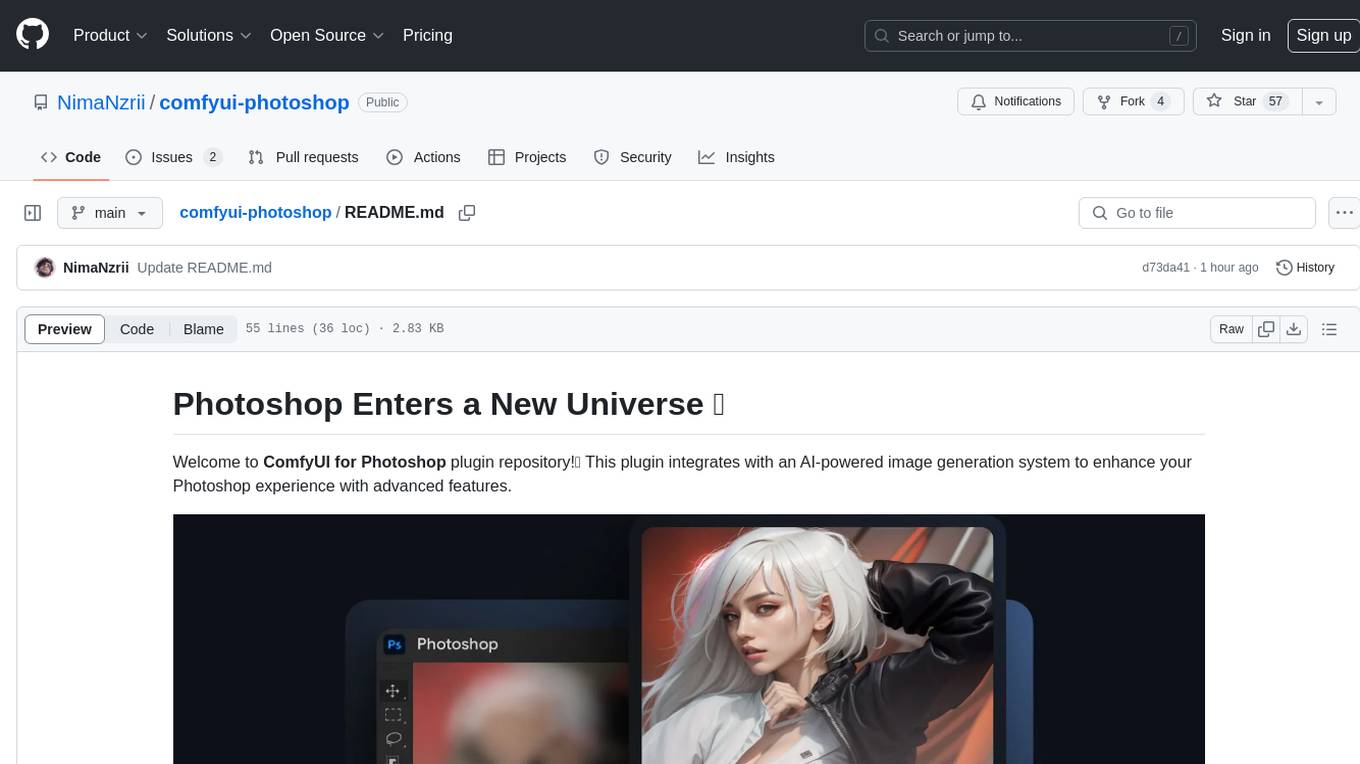
comfyui-photoshop
ComfyUI for Photoshop is a plugin that integrates with an AI-powered image generation system to enhance the Photoshop experience with features like unlimited generative fill, customizable back-end, AI-powered artistry, and one-click transformation. The plugin requires a minimum of 6GB graphics memory and 12GB RAM. Users can install the plugin and set up the ComfyUI workflow using provided links and files. Additionally, specific files like Check points, Loras, and Detailer Lora are required for different functionalities. Support and contributions are encouraged through GitHub.
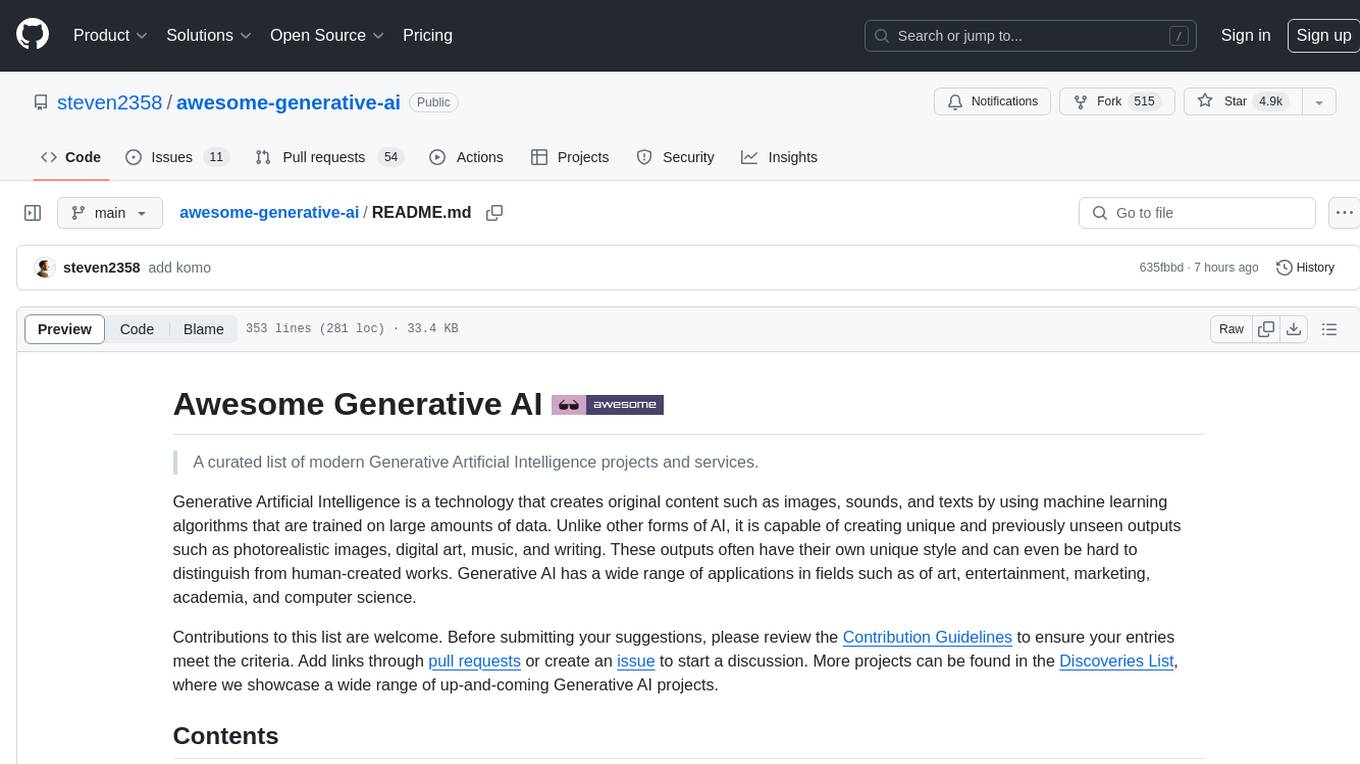
awesome-generative-ai
Awesome Generative AI is a curated list of modern Generative Artificial Intelligence projects and services. Generative AI technology creates original content like images, sounds, and texts using machine learning algorithms trained on large data sets. It can produce unique and realistic outputs such as photorealistic images, digital art, music, and writing. The repo covers a wide range of applications in art, entertainment, marketing, academia, and computer science.
For similar jobs
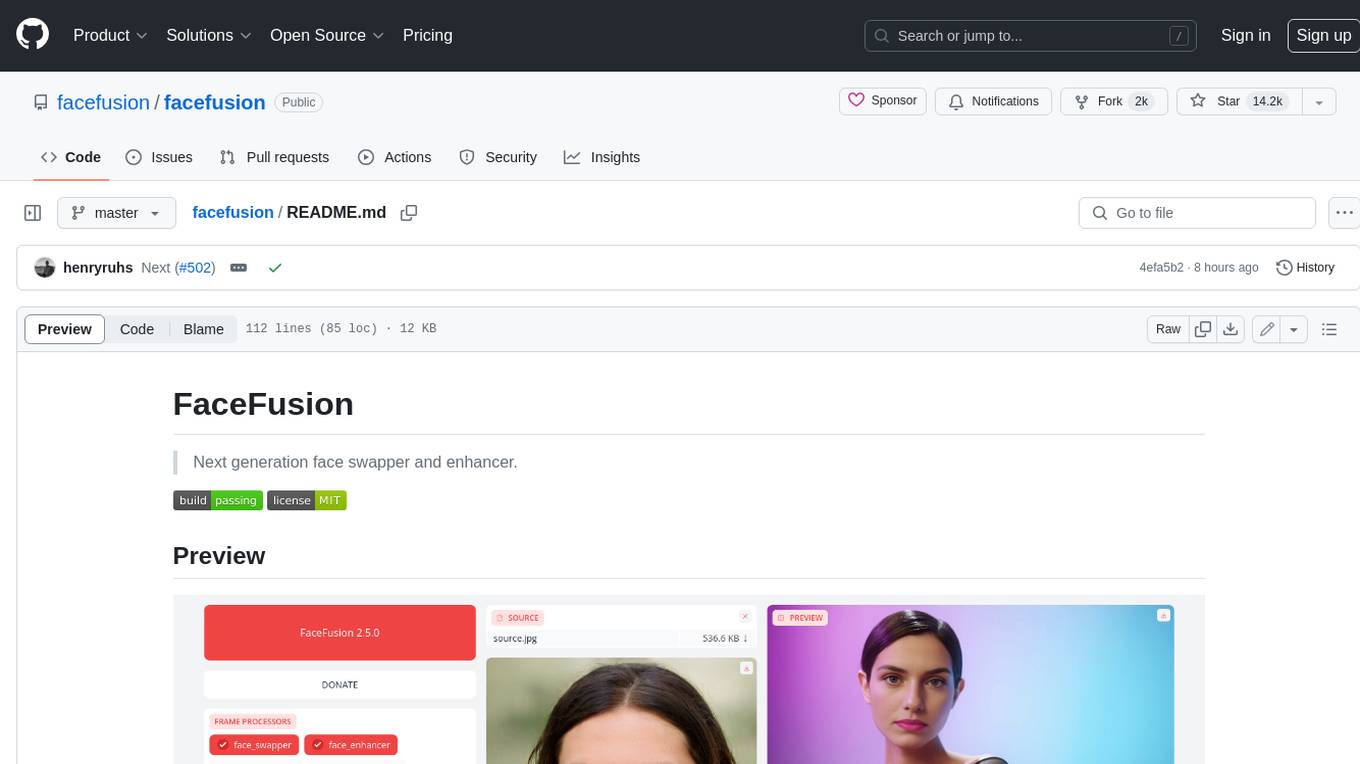
facefusion
FaceFusion is a next-generation face swapper and enhancer that allows users to seamlessly swap faces in images and videos, as well as enhance facial features for a more polished and refined look. With its advanced deep learning models, FaceFusion provides users with a wide range of options for customizing their face swaps and enhancements, making it an ideal tool for content creators, artists, and anyone looking to explore their creativity with facial manipulation.
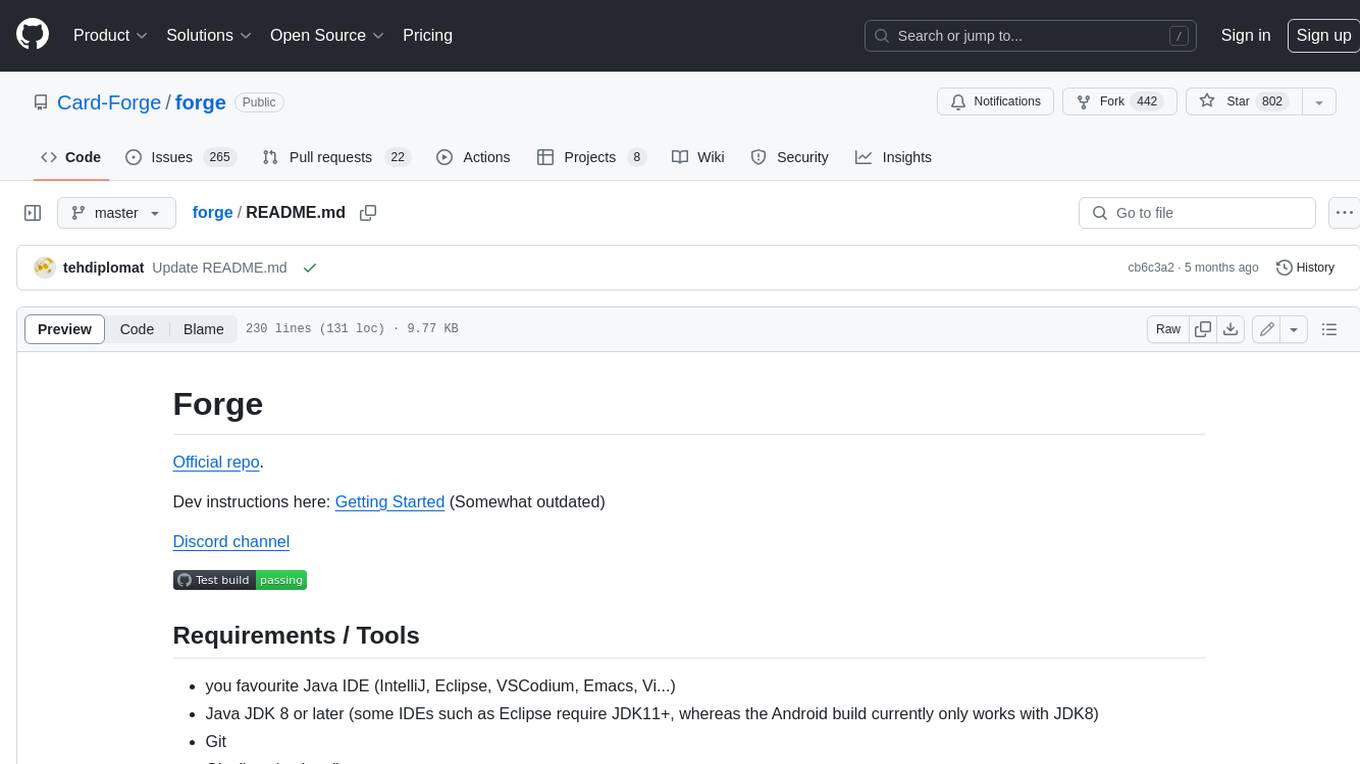
forge
Forge is a free and open-source digital collectible card game (CCG) engine written in Java. It is designed to be easy to use and extend, and it comes with a variety of features that make it a great choice for developers who want to create their own CCGs. Forge is used by a number of popular CCGs, including Ascension, Dominion, and Thunderstone.
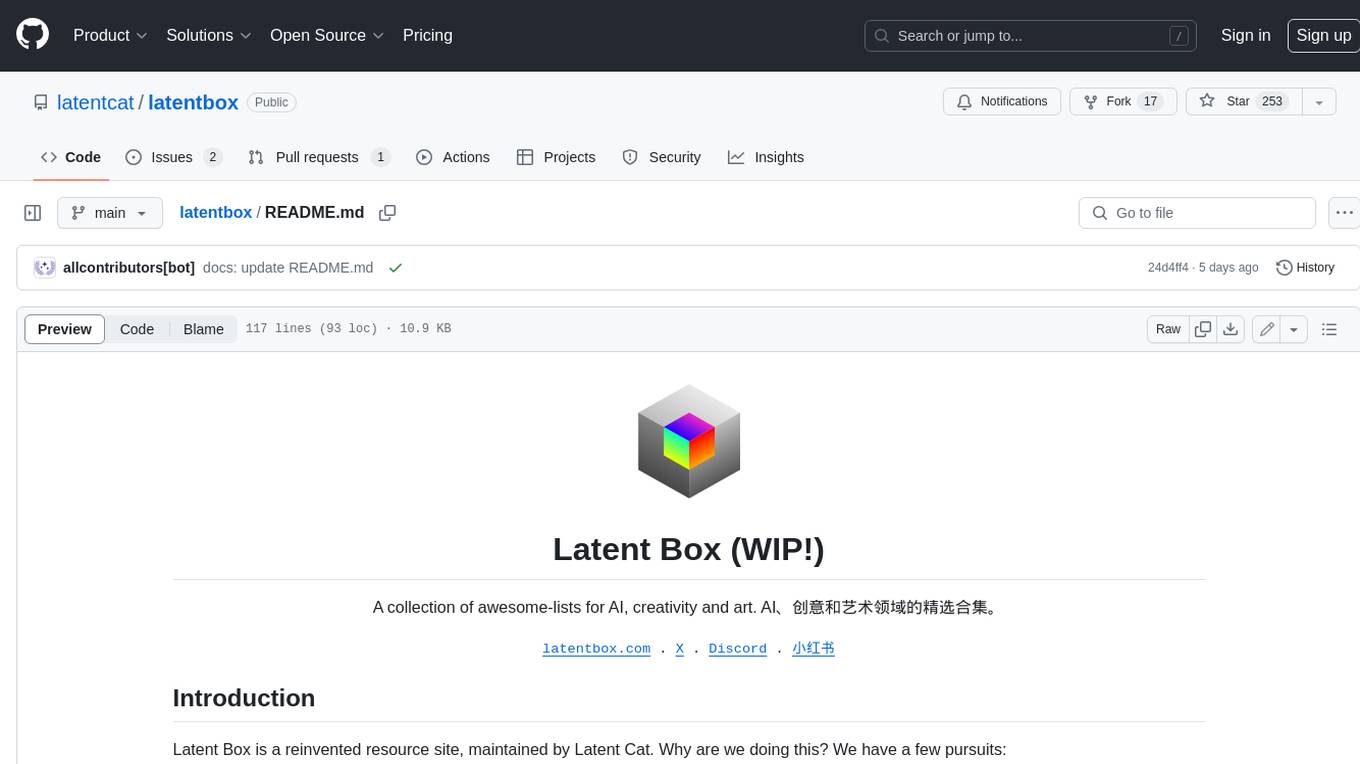
latentbox
Latent Box is a curated collection of resources for AI, creativity, and art. It aims to bridge the information gap with high-quality content, promote diversity and interdisciplinary collaboration, and maintain updates through community co-creation. The website features a wide range of resources, including articles, tutorials, tools, and datasets, covering various topics such as machine learning, computer vision, natural language processing, generative art, and creative coding.

fabric
Fabric is an open-source framework for augmenting humans using AI. It provides a structured approach to breaking down problems into individual components and applying AI to them one at a time. Fabric includes a collection of pre-defined Patterns (prompts) that can be used for a variety of tasks, such as extracting the most interesting parts of YouTube videos and podcasts, writing essays, summarizing academic papers, creating AI art prompts, and more. Users can also create their own custom Patterns. Fabric is designed to be easy to use, with a command-line interface and a variety of helper apps. It is also extensible, allowing users to integrate it with their own AI applications and infrastructure.

ColorPicker
ColorPicker Max is a powerful and intuitive color selection and manipulation tool that is designed to make working with color easier and more efficient than ever before. With its wide range of features and tools, ColorPicker Max offers an unprecedented level of control and customization over every aspect of color selection and manipulation.
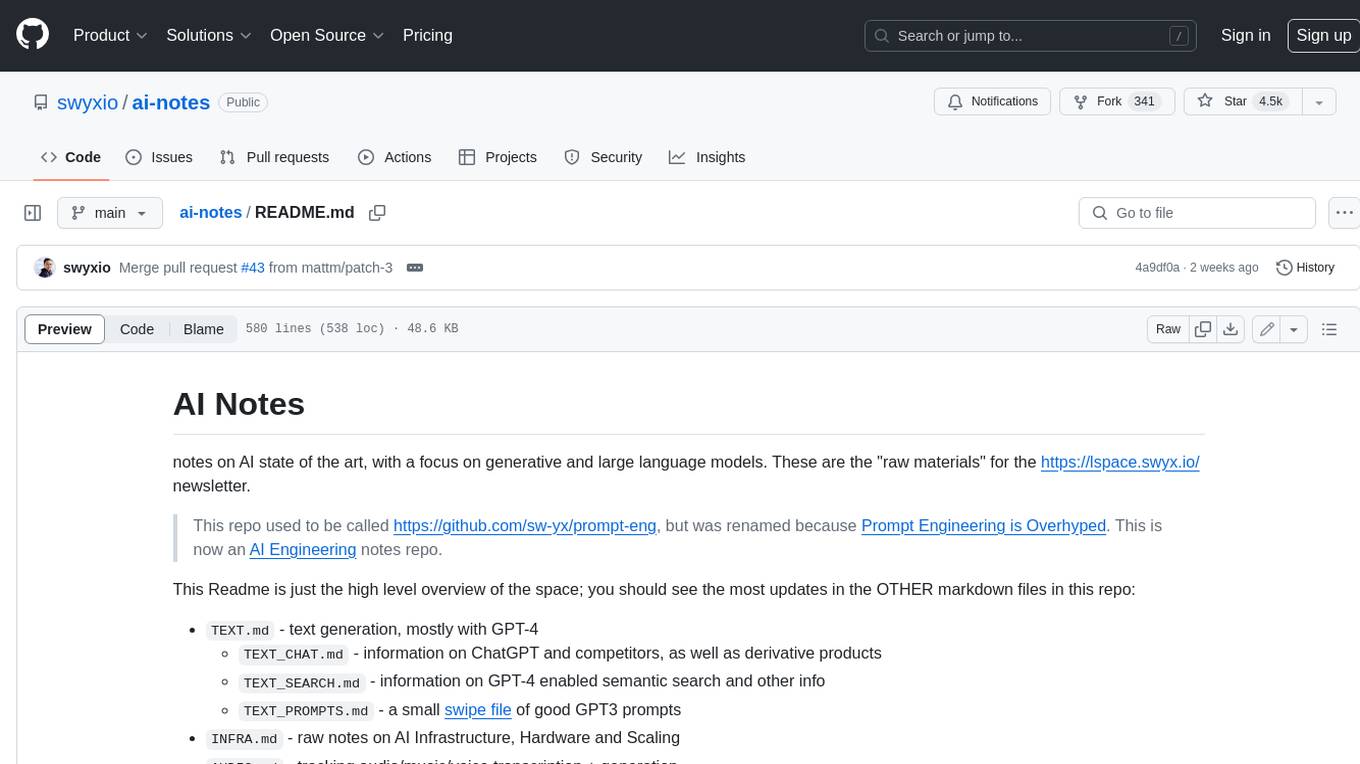
ai-notes
Notes on AI state of the art, with a focus on generative and large language models. These are the "raw materials" for the https://lspace.swyx.io/ newsletter. This repo used to be called https://github.com/sw-yx/prompt-eng, but was renamed because Prompt Engineering is Overhyped. This is now an AI Engineering notes repo.
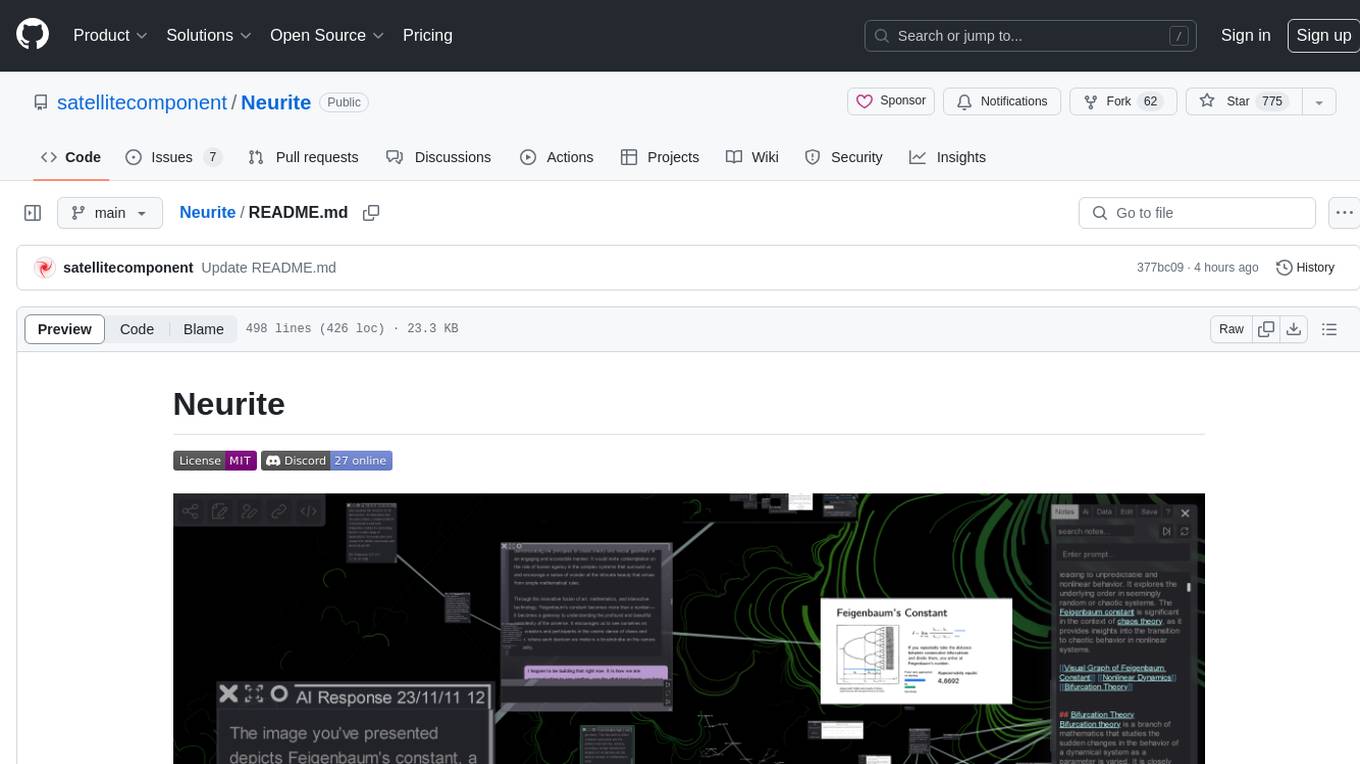
Neurite
Neurite is an innovative project that combines chaos theory and graph theory to create a digital interface that explores hidden patterns and connections for creative thinking. It offers a unique workspace blending fractals with mind mapping techniques, allowing users to navigate the Mandelbrot set in real-time. Nodes in Neurite represent various content types like text, images, videos, code, and AI agents, enabling users to create personalized microcosms of thoughts and inspirations. The tool supports synchronized knowledge management through bi-directional synchronization between mind-mapping and text-based hyperlinking. Neurite also features FractalGPT for modular conversation with AI, local AI capabilities for multi-agent chat networks, and a Neural API for executing code and sequencing animations. The project is actively developed with plans for deeper fractal zoom, advanced control over node placement, and experimental features.
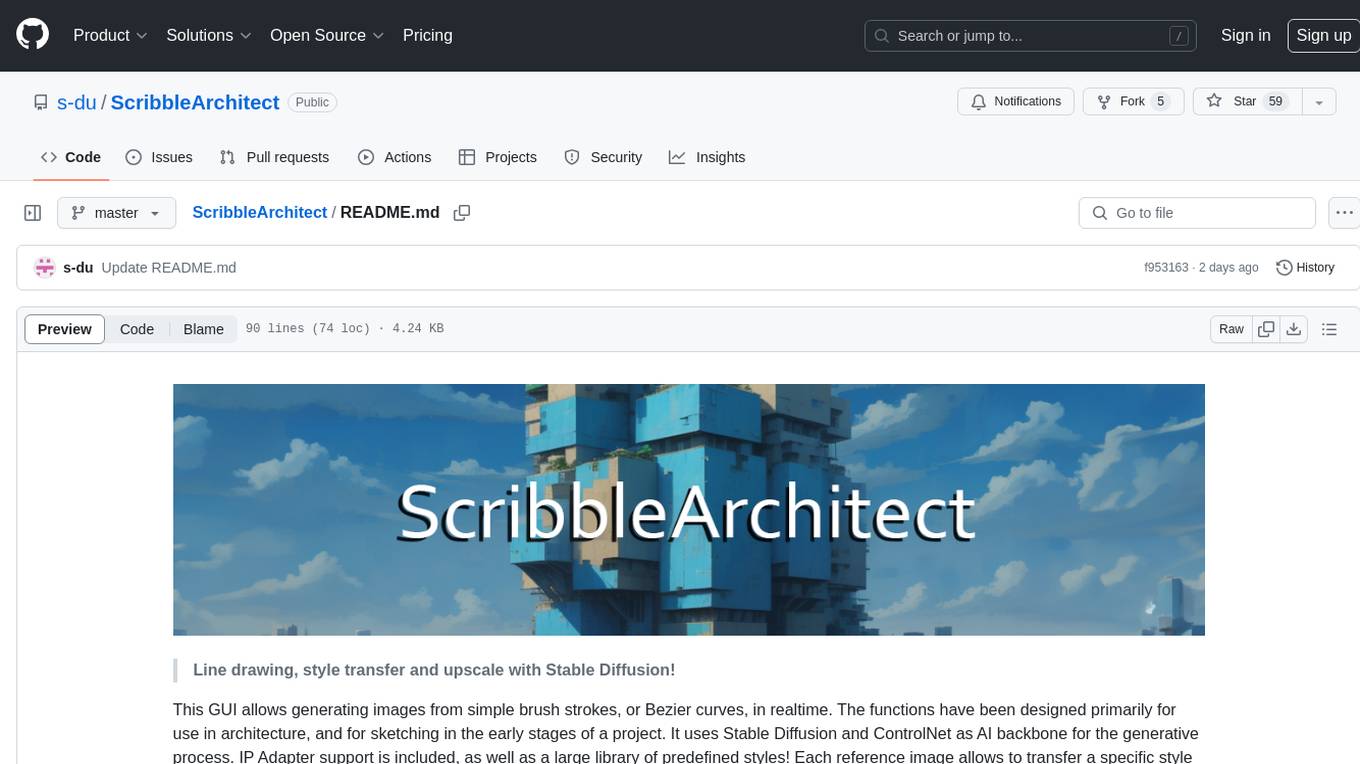
ScribbleArchitect
ScribbleArchitect is a GUI tool designed for generating images from simple brush strokes or Bezier curves in real-time. It is primarily intended for use in architecture and sketching in the early stages of a project. The tool utilizes Stable Diffusion and ControlNet as AI backbone for the generative process, with IP Adapter support and a library of predefined styles. Users can transfer specific styles to their line work, upscale images for high resolution export, and utilize a ControlNet upscaler. The tool also features a screen capture function for working with external tools like Adobe Illustrator or Inkscape.






